We use cookies to give you the best experience possible. By continuing we’ll assume you’re on board with our cookie policy

- A Research Guide
- Research Paper Guide

How to Write a Research Plan
- Research plan definition
- Purpose of a research plan
- Research plan structure
- Step-by-step writing guide
Tips for creating a research plan
- Research plan examples
Research plan: definition and significance
What is the purpose of a research plan.
- Bridging gaps in the existing knowledge related to their subject.
- Reinforcing established research about their subject.
- Introducing insights that contribute to subject understanding.
Research plan structure & template
Introduction.
- What is the existing knowledge about the subject?
- What gaps remain unanswered?
- How will your research enrich understanding, practice, and policy?
Literature review
Expected results.
- Express how your research can challenge established theories in your field.
- Highlight how your work lays the groundwork for future research endeavors.
- Emphasize how your work can potentially address real-world problems.
5 Steps to crafting an effective research plan
Step 1: define the project purpose, step 2: select the research method, step 3: manage the task and timeline, step 4: write a summary, step 5: plan the result presentation.
- Brainstorm Collaboratively: Initiate a collective brainstorming session with peers or experts. Outline the essential questions that warrant exploration and answers within your research.
- Prioritize and Feasibility: Evaluate the list of questions and prioritize those that are achievable and important. Focus on questions that can realistically be addressed.
- Define Key Terminology: Define technical terms pertinent to your research, fostering a shared understanding. Ensure that terms like “church” or “unreached people group” are well-defined to prevent ambiguity.
- Organize your approach: Once well-acquainted with your institution’s regulations, organize each aspect of your research by these guidelines. Allocate appropriate word counts for different sections and components of your research paper.
Research plan example

- Writing a Research Paper
- Research Paper Title
- Research Paper Sources
- Research Paper Problem Statement
- Research Paper Thesis Statement
- Hypothesis for a Research Paper
- Research Question
- Research Paper Outline
- Research Paper Summary
- Research Paper Prospectus
- Research Paper Proposal
- Research Paper Format
- Research Paper Styles
- AMA Style Research Paper
- MLA Style Research Paper
- Chicago Style Research Paper
- APA Style Research Paper
- Research Paper Structure
- Research Paper Cover Page
- Research Paper Abstract
- Research Paper Introduction
- Research Paper Body Paragraph
- Research Paper Literature Review
- Research Paper Background
- Research Paper Methods Section
- Research Paper Results Section
- Research Paper Discussion Section
- Research Paper Conclusion
- Research Paper Appendix
- Research Paper Bibliography
- APA Reference Page
- Annotated Bibliography
- Bibliography vs Works Cited vs References Page
- Research Paper Types
- What is Qualitative Research

Receive paper in 3 Hours!
- Choose the number of pages.
- Select your deadline.
- Complete your order.
Number of Pages
550 words (double spaced)
Deadline: 10 days left
By clicking "Log In", you agree to our terms of service and privacy policy . We'll occasionally send you account related and promo emails.
Sign Up for your FREE account

Get a 50% off
Study smarter with Chegg and save your time and money today!
Reference management. Clean and simple.
Getting started with your research paper outline

Levels of organization for a research paper outline
First level of organization, second level of organization, third level of organization, fourth level of organization, tips for writing a research paper outline, research paper outline template, my research paper outline is complete: what are the next steps, frequently asked questions about a research paper outline, related articles.
The outline is the skeleton of your research paper. Simply start by writing down your thesis and the main ideas you wish to present. This will likely change as your research progresses; therefore, do not worry about being too specific in the early stages of writing your outline.
A research paper outline typically contains between two and four layers of organization. The first two layers are the most generalized. Each layer thereafter will contain the research you complete and presents more and more detailed information.
The levels are typically represented by a combination of Roman numerals, Arabic numerals, uppercase letters, lowercase letters but may include other symbols. Refer to the guidelines provided by your institution, as formatting is not universal and differs between universities, fields, and subjects. If you are writing the outline for yourself, you may choose any combination you prefer.
This is the most generalized level of information. Begin by numbering the introduction, each idea you will present, and the conclusion. The main ideas contain the bulk of your research paper 's information. Depending on your research, it may be chapters of a book for a literature review , a series of dates for a historical research paper, or the methods and results of a scientific paper.
I. Introduction
II. Main idea
III. Main idea
IV. Main idea
V. Conclusion
The second level consists of topics which support the introduction, main ideas, and the conclusion. Each main idea should have at least two supporting topics listed in the outline.
If your main idea does not have enough support, you should consider presenting another main idea in its place. This is where you should stop outlining if this is your first draft. Continue your research before adding to the next levels of organization.
- A. Background information
- B. Hypothesis or thesis
- A. Supporting topic
- B. Supporting topic
The third level of organization contains supporting information for the topics previously listed. By now, you should have completed enough research to add support for your ideas.
The Introduction and Main Ideas may contain information you discovered about the author, timeframe, or contents of a book for a literature review; the historical events leading up to the research topic for a historical research paper, or an explanation of the problem a scientific research paper intends to address.
- 1. Relevant history
- 2. Relevant history
- 1. The hypothesis or thesis clearly stated
- 1. A brief description of supporting information
- 2. A brief description of supporting information
The fourth level of organization contains the most detailed information such as quotes, references, observations, or specific data needed to support the main idea. It is not typical to have further levels of organization because the information contained here is the most specific.
- a) Quotes or references to another piece of literature
- b) Quotes or references to another piece of literature
Tip: The key to creating a useful outline is to be consistent in your headings, organization, and levels of specificity.
- Be Consistent : ensure every heading has a similar tone. State the topic or write short sentences for each heading but avoid doing both.
- Organize Information : Higher levels of organization are more generally stated and each supporting level becomes more specific. The introduction and conclusion will never be lower than the first level of organization.
- Build Support : Each main idea should have two or more supporting topics. If your research does not have enough information to support the main idea you are presenting, you should, in general, complete additional research or revise the outline.
By now, you should know the basic requirements to create an outline for your paper. With a content framework in place, you can now start writing your paper . To help you start right away, you can use one of our templates and adjust it to suit your needs.
After completing your outline, you should:
- Title your research paper . This is an iterative process and may change when you delve deeper into the topic.
- Begin writing your research paper draft . Continue researching to further build your outline and provide more information to support your hypothesis or thesis.
- Format your draft appropriately . MLA 8 and APA 7 formats have differences between their bibliography page, in-text citations, line spacing, and title.
- Finalize your citations and bibliography . Use a reference manager like Paperpile to organize and cite your research.
- Write the abstract, if required . An abstract will briefly state the information contained within the paper, results of the research, and the conclusion.
An outline is used to organize written ideas about a topic into a logical order. Outlines help us organize major topics, subtopics, and supporting details. Researchers benefit greatly from outlines while writing by addressing which topic to cover in what order.
The most basic outline format consists of: an introduction, a minimum of three topic paragraphs, and a conclusion.
You should make an outline before starting to write your research paper. This will help you organize the main ideas and arguments you want to present in your topic.
- Consistency: ensure every heading has a similar tone. State the topic or write short sentences for each heading but avoid doing both.
- Organization : Higher levels of organization are more generally stated and each supporting level becomes more specific. The introduction and conclusion will never be lower than the first level of organization.
- Support : Each main idea should have two or more supporting topics. If your research does not have enough information to support the main idea you are presenting, you should, in general, complete additional research or revise the outline.

- Privacy Policy

Home » Research Paper Outline – Types, Example, Template
Research Paper Outline – Types, Example, Template
Table of Contents

By creating a well-structured research paper outline, writers can easily organize their thoughts and ideas and ensure that their final paper is clear, concise, and effective. In this article, we will explore the essential components of a research paper outline and provide some tips and tricks for creating a successful one.
Research Paper Outline
Research paper outline is a plan or a structural framework that organizes the main ideas , arguments, and supporting evidence in a logical sequence. It serves as a blueprint or a roadmap for the writer to follow while drafting the actual research paper .
Typically, an outline consists of the following elements:
- Introduction : This section presents the topic, research question , and thesis statement of the paper. It also provides a brief overview of the literature review and the methodology used.
- Literature Review: This section provides a comprehensive review of the relevant literature, theories, and concepts related to the research topic. It analyzes the existing research and identifies the research gaps and research questions.
- Methodology: This section explains the research design, data collection methods, data analysis, and ethical considerations of the study.
- Results: This section presents the findings of the study, using tables, graphs, and statistics to illustrate the data.
- Discussion : This section interprets the results of the study, and discusses their implications, significance, and limitations. It also suggests future research directions.
- Conclusion : This section summarizes the main findings of the study and restates the thesis statement.
- References: This section lists all the sources cited in the paper using the appropriate citation style.
Research Paper Outline Types
There are several types of outlines that can be used for research papers, including:
Alphanumeric Outline
This is a traditional outline format that uses Roman numerals, capital letters, Arabic numerals, and lowercase letters to organize the main ideas and supporting details of a research paper. It is commonly used for longer, more complex research papers.
I. Introduction
- A. Background information
- B. Thesis statement
- 1 1. Supporting detail
- 1 2. Supporting detail 2
- 2 1. Supporting detail
III. Conclusion
- A. Restate thesis
- B. Summarize main points
Decimal Outline
This outline format uses numbers to organize the main ideas and supporting details of a research paper. It is similar to the alphanumeric outline, but it uses only numbers and decimals to indicate the hierarchy of the ideas.
- 1.1 Background information
- 1.2 Thesis statement
- 1 2.1.1 Supporting detail
- 1 2.1.2 Supporting detail
- 2 2.2.1 Supporting detail
- 1 2.2.2 Supporting detail
- 3.1 Restate thesis
- 3.2 Summarize main points
Full Sentence Outline
This type of outline uses complete sentences to describe the main ideas and supporting details of a research paper. It is useful for those who prefer to see the entire paper outlined in complete sentences.
- Provide background information on the topic
- State the thesis statement
- Explain main idea 1 and provide supporting details
- Discuss main idea 2 and provide supporting details
- Restate the thesis statement
- Summarize the main points of the paper
Topic Outline
This type of outline uses short phrases or words to describe the main ideas and supporting details of a research paper. It is useful for those who prefer to see a more concise overview of the paper.
- Background information
- Thesis statement
- Supporting detail 1
- Supporting detail 2
- Restate thesis
- Summarize main points
Reverse Outline
This is an outline that is created after the paper has been written. It involves going back through the paper and summarizing each paragraph or section in one sentence. This can be useful for identifying gaps in the paper or areas that need further development.
- Introduction : Provides background information and states the thesis statement.
- Paragraph 1: Discusses main idea 1 and provides supporting details.
- Paragraph 2: Discusses main idea 2 and provides supporting details.
- Paragraph 3: Addresses potential counterarguments.
- Conclusion : Restates thesis and summarizes main points.
Mind Map Outline
This type of outline involves creating a visual representation of the main ideas and supporting details of a research paper. It can be useful for those who prefer a more creative and visual approach to outlining.
- Supporting detail 1: Lack of funding for public schools.
- Supporting detail 2: Decrease in government support for education.
- Supporting detail 1: Increase in income inequality.
- Supporting detail 2: Decrease in social mobility.
Research Paper Outline Example
Research Paper Outline Example on Cyber Security:
A. Overview of Cybersecurity
- B. Importance of Cybersecurity
- C. Purpose of the paper
II. Cyber Threats
A. Definition of Cyber Threats
- B. Types of Cyber Threats
- C. Examples of Cyber Threats
III. Cybersecurity Measures
A. Prevention measures
- Anti-virus software
- Encryption B. Detection measures
- Intrusion Detection System (IDS)
- Security Information and Event Management (SIEM)
- Security Operations Center (SOC) C. Response measures
- Incident Response Plan
- Business Continuity Plan
- Disaster Recovery Plan
IV. Cybersecurity in the Business World
A. Overview of Cybersecurity in the Business World
B. Cybersecurity Risk Assessment
C. Best Practices for Cybersecurity in Business
V. Cybersecurity in Government Organizations
A. Overview of Cybersecurity in Government Organizations
C. Best Practices for Cybersecurity in Government Organizations
VI. Cybersecurity Ethics
A. Definition of Cybersecurity Ethics
B. Importance of Cybersecurity Ethics
C. Examples of Cybersecurity Ethics
VII. Future of Cybersecurity
A. Overview of the Future of Cybersecurity
B. Emerging Cybersecurity Threats
C. Advancements in Cybersecurity Technology
VIII. Conclusion
A. Summary of the paper
B. Recommendations for Cybersecurity
- C. Conclusion.
IX. References
A. List of sources cited in the paper
B. Bibliography of additional resources
Introduction
Cybersecurity refers to the protection of computer systems, networks, and sensitive data from unauthorized access, theft, damage, or any other form of cyber attack. B. Importance of Cybersecurity The increasing reliance on technology and the growing number of cyber threats make cybersecurity an essential aspect of modern society. Cybersecurity breaches can result in financial losses, reputational damage, and legal liabilities. C. Purpose of the paper This paper aims to provide an overview of cybersecurity, cyber threats, cybersecurity measures, cybersecurity in the business and government sectors, cybersecurity ethics, and the future of cybersecurity.
A cyber threat is any malicious act or event that attempts to compromise or disrupt computer systems, networks, or sensitive data. B. Types of Cyber Threats Common types of cyber threats include malware, phishing, social engineering, ransomware, DDoS attacks, and advanced persistent threats (APTs). C. Examples of Cyber Threats Recent cyber threats include the SolarWinds supply chain attack, the Colonial Pipeline ransomware attack, and the Microsoft Exchange Server hack.
Prevention measures aim to minimize the risk of cyber attacks by implementing security controls, such as firewalls, anti-virus software, and encryption.
- Firewalls Firewalls act as a barrier between a computer network and the internet, filtering incoming and outgoing traffic to prevent unauthorized access.
- Anti-virus software Anti-virus software detects, prevents, and removes malware from computer systems.
- Encryption Encryption involves the use of mathematical algorithms to transform sensitive data into a code that can only be accessed by authorized individuals. B. Detection measures Detection measures aim to identify and respond to cyber attacks as quickly as possible, such as intrusion detection systems (IDS), security information and event management (SIEM), and security operations centers (SOCs).
- Intrusion Detection System (IDS) IDS monitors network traffic for signs of unauthorized access, such as unusual patterns or anomalies.
- Security Information and Event Management (SIEM) SIEM combines security information management and security event management to provide real-time monitoring and analysis of security alerts.
- Security Operations Center (SOC) SOC is a dedicated team responsible for monitoring, analyzing, and responding to cyber threats. C. Response measures Response measures aim to mitigate the impact of a cyber attack and restore normal operations, such as incident response plans (IRPs), business continuity plans (BCPs), and disaster recovery plans (DRPs).
- Incident Response Plan IRPs outline the procedures and protocols to follow in the event of a cyber attack, including communication protocols, roles and responsibilities, and recovery processes.
- Business Continuity Plan BCPs ensure that critical business functions can continue in the event of a cyber attack or other disruption.
- Disaster Recovery Plan DRPs outline the procedures to recover from a catastrophic event, such as a natural disaster or cyber attack.
Cybersecurity is crucial for businesses of all sizes and industries, as they handle sensitive data, financial transactions, and intellectual property that are attractive targets for cyber criminals.
Risk assessment is a critical step in developing a cybersecurity strategy, which involves identifying potential threats, vulnerabilities, and consequences to determine the level of risk and prioritize security measures.
Best practices for cybersecurity in business include implementing strong passwords and multi-factor authentication, regularly updating software and hardware, training employees on cybersecurity awareness, and regularly backing up data.
Government organizations face unique cybersecurity challenges, as they handle sensitive information related to national security, defense, and critical infrastructure.
Risk assessment in government organizations involves identifying and assessing potential threats and vulnerabilities, conducting regular audits, and complying with relevant regulations and standards.
Best practices for cybersecurity in government organizations include implementing secure communication protocols, regularly updating and patching software, and conducting regular cybersecurity training and awareness programs for employees.
Cybersecurity ethics refers to the ethical considerations involved in cybersecurity, such as privacy, data protection, and the responsible use of technology.
Cybersecurity ethics are crucial for maintaining trust in technology, protecting privacy and data, and promoting responsible behavior in the digital world.
Examples of cybersecurity ethics include protecting the privacy of user data, ensuring data accuracy and integrity, and implementing fair and unbiased algorithms.
The future of cybersecurity will involve a shift towards more advanced technologies, such as artificial intelligence (AI), machine learning, and quantum computing.
Emerging cybersecurity threats include AI-powered cyber attacks, the use of deepfakes and synthetic media, and the potential for quantum computing to break current encryption methods.
Advancements in cybersecurity technology include the development of AI and machine learning-based security tools, the use of blockchain for secure data storage and sharing, and the development of post-quantum encryption methods.
This paper has provided an overview of cybersecurity, cyber threats, cybersecurity measures, cybersecurity in the business and government sectors, cybersecurity ethics, and the future of cybersecurity.
To enhance cybersecurity, organizations should prioritize risk assessment and implement a comprehensive cybersecurity strategy that includes prevention, detection, and response measures. Additionally, organizations should prioritize cybersecurity ethics to promote responsible behavior in the digital world.
C. Conclusion
Cybersecurity is an essential aspect of modern society, and organizations must prioritize cybersecurity to protect sensitive data and maintain trust in technology.
for further reading
X. Appendices
A. Glossary of key terms
B. Cybersecurity checklist for organizations
C. Sample cybersecurity policy for businesses
D. Sample cybersecurity incident response plan
E. Cybersecurity training and awareness resources
Note : The content and organization of the paper may vary depending on the specific requirements of the assignment or target audience. This outline serves as a general guide for writing a research paper on cybersecurity. Do not use this in your assingmets.
Research Paper Outline Template
- Background information and context of the research topic
- Research problem and questions
- Purpose and objectives of the research
- Scope and limitations
II. Literature Review
- Overview of existing research on the topic
- Key concepts and theories related to the research problem
- Identification of gaps in the literature
- Summary of relevant studies and their findings
III. Methodology
- Research design and approach
- Data collection methods and procedures
- Data analysis techniques
- Validity and reliability considerations
- Ethical considerations
IV. Results
- Presentation of research findings
- Analysis and interpretation of data
- Explanation of significant results
- Discussion of unexpected results
V. Discussion
- Comparison of research findings with existing literature
- Implications of results for theory and practice
- Limitations and future directions for research
- Conclusion and recommendations
VI. Conclusion
- Summary of research problem, purpose, and objectives
- Discussion of significant findings
- Contribution to the field of study
- Implications for practice
- Suggestions for future research
VII. References
- List of sources cited in the research paper using appropriate citation style.
Note : This is just an template, and depending on the requirements of your assignment or the specific research topic, you may need to modify or adjust the sections or headings accordingly.
Research Paper Outline Writing Guide
Here’s a guide to help you create an effective research paper outline:
- Choose a topic : Select a topic that is interesting, relevant, and meaningful to you.
- Conduct research: Gather information on the topic from a variety of sources, such as books, articles, journals, and websites.
- Organize your ideas: Organize your ideas and information into logical groups and subgroups. This will help you to create a clear and concise outline.
- Create an outline: Begin your outline with an introduction that includes your thesis statement. Then, organize your ideas into main points and subpoints. Each main point should be supported by evidence and examples.
- Introduction: The introduction of your research paper should include the thesis statement, background information, and the purpose of the research paper.
- Body : The body of your research paper should include the main points and subpoints. Each point should be supported by evidence and examples.
- Conclusion : The conclusion of your research paper should summarize the main points and restate the thesis statement.
- Reference List: Include a reference list at the end of your research paper. Make sure to properly cite all sources used in the paper.
- Proofreading : Proofread your research paper to ensure that it is free of errors and grammatical mistakes.
- Finalizing : Finalize your research paper by reviewing the outline and making any necessary changes.
When to Write Research Paper Outline
It’s a good idea to write a research paper outline before you begin drafting your paper. The outline will help you organize your thoughts and ideas, and it can serve as a roadmap for your writing process.
Here are a few situations when you might want to consider writing an outline:
- When you’re starting a new research project: If you’re beginning a new research project, an outline can help you get organized from the very beginning. You can use your outline to brainstorm ideas, map out your research goals, and identify potential sources of information.
- When you’re struggling to organize your thoughts: If you find yourself struggling to organize your thoughts or make sense of your research, an outline can be a helpful tool. It can help you see the big picture of your project and break it down into manageable parts.
- When you’re working with a tight deadline : If you have a deadline for your research paper, an outline can help you stay on track and ensure that you cover all the necessary points. By mapping out your paper in advance, you can work more efficiently and avoid getting stuck or overwhelmed.
Purpose of Research Paper Outline
The purpose of a research paper outline is to provide a structured and organized plan for the writer to follow while conducting research and writing the paper. An outline is essentially a roadmap that guides the writer through the entire research process, from the initial research and analysis of the topic to the final writing and editing of the paper.
A well-constructed outline can help the writer to:
- Organize their thoughts and ideas on the topic, and ensure that all relevant information is included.
- Identify any gaps in their research or argument, and address them before starting to write the paper.
- Ensure that the paper follows a logical and coherent structure, with clear transitions between different sections.
- Save time and effort by providing a clear plan for the writer to follow, rather than starting from scratch and having to revise the paper multiple times.
Advantages of Research Paper Outline
Some of the key advantages of a research paper outline include:
- Helps to organize thoughts and ideas : An outline helps to organize all the different ideas and information that you want to include in your paper. By creating an outline, you can ensure that all the points you want to make are covered and in a logical order.
- Saves time and effort : An outline saves time and effort because it helps you to focus on the key points of your paper. It also helps you to identify any gaps or areas where more research may be needed.
- Makes the writing process easier : With an outline, you have a clear roadmap of what you want to write, and this makes the writing process much easier. You can simply follow your outline and fill in the details as you go.
- Improves the quality of your paper : By having a clear outline, you can ensure that all the important points are covered and in a logical order. This makes your paper more coherent and easier to read, which ultimately improves its overall quality.
- Facilitates collaboration: If you are working on a research paper with others, an outline can help to facilitate collaboration. By sharing your outline, you can ensure that everyone is on the same page and working towards the same goals.
About the author
Muhammad Hassan
Researcher, Academic Writer, Web developer
You may also like

How to Cite Research Paper – All Formats and...

Delimitations in Research – Types, Examples and...

Research Paper Format – Types, Examples and...

Research Design – Types, Methods and Examples

Research Paper Title – Writing Guide and Example

Research Paper Introduction – Writing Guide and...
FLEET LIBRARY | Research Guides
Rhode island school of design, create a research plan: research plan.
- Research Plan
- Literature Review
- Ulrich's Global Serials Directory
- Related Guides
A research plan is a framework that shows how you intend to approach your topic. The plan can take many forms: a written outline, a narrative, a visual/concept map or timeline. It's a document that will change and develop as you conduct your research. Components of a research plan
1. Research conceptualization - introduces your research question
2. Research methodology - describes your approach to the research question
3. Literature review, critical evaluation and synthesis - systematic approach to locating,
reviewing and evaluating the work (text, exhibitions, critiques, etc) relating to your topic
4. Communication - geared toward an intended audience, shows evidence of your inquiry
Research conceptualization refers to the ability to identify specific research questions, problems or opportunities that are worthy of inquiry. Research conceptualization also includes the skills and discipline that go beyond the initial moment of conception, and which enable the researcher to formulate and develop an idea into something researchable ( Newbury 373).
Research methodology refers to the knowledge and skills required to select and apply appropriate methods to carry through the research project ( Newbury 374) .
Method describes a single mode of proceeding; methodology describes the overall process.
Method - a way of doing anything especially according to a defined and regular plan; a mode of procedure in any activity
Methodology - the study of the direction and implications of empirical research, or the sustainability of techniques employed in it; a method or body of methods used in a particular field of study or activity *Browse a list of research methodology books or this guide on Art & Design Research
Literature Review, critical evaluation & synthesis
A literature review is a systematic approach to locating, reviewing, and evaluating the published work and work in progress of scholars, researchers, and practitioners on a given topic.
Critical evaluation and synthesis is the ability to handle (or process) existing sources. It includes knowledge of the sources of literature and contextual research field within which the person is working ( Newbury 373).
Literature reviews are done for many reasons and situations. Here's a short list:
Sources to consult while conducting a literature review:
Online catalogs of local, regional, national, and special libraries
meta-catalogs such as worldcat , Art Discovery Group , europeana , world digital library or RIBA
subject-specific online article databases (such as the Avery Index, JSTOR, Project Muse)
digital institutional repositories such as Digital Commons @RISD ; see Registry of Open Access Repositories
Open Access Resources recommended by RISD Research LIbrarians
works cited in scholarly books and articles
print bibliographies
the internet-locate major nonprofit, research institutes, museum, university, and government websites
search google scholar to locate grey literature & referenced citations
trade and scholarly publishers
fellow scholars and peers
Communication
Communication refers to the ability to
- structure a coherent line of inquiry
- communicate your findings to your intended audience
- make skilled use of visual material to express ideas for presentations, writing, and the creation of exhibitions ( Newbury 374)
Research plan framework: Newbury, Darren. "Research Training in the Creative Arts and Design." The Routledge Companion to Research in the Arts . Ed. Michael Biggs and Henrik Karlsson. New York: Routledge, 2010. 368-87. Print.
About the author
Except where otherwise noted, this guide is subject to a Creative Commons Attribution license
source document
Routledge Companion to Research in the Arts
- Next: Literature Review >>
- Last Updated: Sep 20, 2023 5:05 PM
- URL: https://risd.libguides.com/researchplan
How to create a helpful research paper outline
Last updated
21 December 2023
Reviewed by
You need to structure your research paper in an orderly way that makes it easy for readers to follow your reasoning and supporting data. That's where a research paper outline can help.
Writing a research paper outline will help you arrange your ideas logically and allow your final paper to flow. It will make the entire process more manageable and help you work out which details to include and which are better left out.
- What is a research paper outline?
Write your research paper outline before starting your first draft. The outline provides a map of how you will structure your ideas throughout the paper. A research paper outline will help you to be more efficient when ordering the sections of your thesis, rather than trying to make structural changes after finishing an entire first draft.
An outline consists of the main topics and subtopics of your paper, listed in a logical order. The main topics will become the sections of your research paper, and the subtopics reveal the content you want to include or discuss under the main topics.
Under each subtopic, you can also jot down items you don't want to forget to include in your research paper, such as:
Topic ideas
Paragraph ideas
Direct quotes
Once you start listing these under your main topics, you can focus your thoughts as you plan and write the research paper using the evidence and data you collected and any additional information.
- Why use an outline?
If your research paper does not have a clear, logical order, readers may not understand the ideas you're trying to share, or they may lose interest and not bother to read the whole paper. An outline helps you structure your research paper so readers can easily connect the content, ideas, and theories you're trying to prove or maintain.
- Are there different kinds of research paper outlines?
Different kinds of research paper outlines might seem similar but have different purposes. You can select an outline type that provides a clear road map and thoroughly explores each point.
Other types will help structure content logically or with a segmented flow and progression of ideas that align closely with the theme of your research.
- The 3 types of outlines
The three outline formats available to research paper writers are:
Alphanumeric or topic outlines
Sentence or full-sentence outlines
Decimal outlines
Let’s look at the differences between each type and see how one may be more beneficial than another, depending on the nature of your research.
This type of research paper outline allows you to segment main headings and subheadings with an alphanumeric arrangement.
The alphanumeric characters of Roman numerals, capital letters, numbers, and lowercase letters define the hierarchy of main topic headings, subtopic headings, and third- and fourth-tier subtopic headings. (e.g., I, A, 1, a)
This method uses minimal words to describe the main and subtopic headings. You'll mostly use this type of research paper outline to focus on the organization of the content while allowing you to review it for unrelated or irrelevant information.
Full-sentence outlines
You will format this type of research paper outline as an alphanumeric outline, using the same alphanumeric characters. However, it contains complete sentences rather than a few words for each main and subtopic heading.
This formatting method allows the writer to focus on looking for inaccuracies and inconsistencies in each point before starting the first draft.
Instead of using alphanumeric characters to define main headings, subheadings, and third- and fourth-tier subheadings, the decimal outline uses a decimal numbering system.
This system shows a logical progression of the content by using 1.0 for the main section heading (and 2.0, 3.0, etc., for subsequent sections), 1.1 for the subheading, 1.1.1 for a third-tier subheading, and 1.1.1.1 for the fourth-tier subheading.
The headings and subheadings will be just a few words, as in the alphanumerical research paper outline. Decimal outlines allow the writer to focus on the content's overall coherence, increasing your writing efficiency and reducing the time it takes to write your research paper.
- How to write a research paper outline
Before you begin your research paper outline, you need to determine your topic and gather your information. Let’s look at these steps first, then dive into how to write your outline.
1. Determine your topic
You'll need to establish a topic or the main point you intend to write about.
For example, you may want to research and write about whether influencers are the most beneficial way to promote products in your industry. This topic is the main point around which your essay will revolve.
2. Gather information
You'll need evidence, data, statistics, and facts to prove or disprove that influencers are the best method of promoting products in your industry.
You'll insert any of these things you collect to substantiate your findings into the outline to support your topic.
3. Determine the type of essay you'll be writing
There are many types of essays or research papers you can write. The kinds of essays include:
Argumentative: Builds logic and support for an argument
Cause and effect: Explains relationships between specific conditions and their results
Analytical: Presents a claim on what is being analyzed
Interpretive: Informative and persuasive explanations on how something is perceived
Experimental: Reports on experimental results and the reasoning behind the results
Review: Offers an understanding and analysis of primary sources on a given topic
Definition: Defines what a term or concept means
Persuasive: Uses logic and reason to show that one idea is more justified than another
Narrative: Tells a story of personal experience from the author’s point of view
Expository: Shows an objective view of a subject by exploring various angles
Descriptive: Describes objects, people, places, experiences, emotions, situations, etc.
Once you understand the essay format you are writing, you'll know how to structure your outline.
4. Include basic sections
You'll begin to structure your outline using basic sections. Your main topic headings for these sections may include an introduction, multiple body paragraph sections, and a conclusion.
Once you establish the sections, you can insert the subtopics under each main topic heading.
5. Organize your outline
For example, if you're writing an argumentative essay taking the position that brand influencers (e.g., social media stars on Instagram or TikTok) are the best way to promote products in your industry, you will argue for that particular position.
You'll organize your argumentative essay outline with a main topic section supporting the position. The subtopics will include the reasoning behind your arguments, and the third-tier subtopics will contain the supporting evidence and data you gathered during your research.
You'll add another main topic section to counter and respond to any opposing arguments. Once you've organized and included all the information in this way, this will provide the structure to start your argumentative essay draft.
6. Consider compare-and-contrast essays
A compare-and-contrast essay is a form of essay that analyzes the differences between two opposing theories or subjects. If you have multiple subjects that are the same or different in just one aspect, you can write a point-by-point outline exploring each subject in terms of this characteristic.
The main topic headings will list that one characteristic, and the subtopic headings will list the subjects or items that are the same or different in relation to this characteristic.
Conversely, if you have multiple items to compare, but they have many characteristics that are similar or different, you can write a block method outline. The main topic headings will contain the items to be compared, while the subtopic headings will contain the aspects in which they are similar or different.
7. Consider advanced organizers for longer essays
An advanced organizer is a sentence that introduces new topics by connecting already-known information to new information. It can also prepare the reader for what they may expect to learn from the entire essay, or each section or paragraph.
Incorporating advanced organizers makes it easier for the reader to process and understand the information you are trying to convey. If you choose to use advanced organizers, depending on how often you want to use them throughout your paper, you can add them to your outline at the end of the introduction, the beginning of a section, or the beginning of each paragraph.
- Do outlines need periods (full stops)?
If you're constructing alphanumerical or decimal topic outlines, they do not need periods because the entries are usually not complete sentences. However, outlines containing full sentences will need to be punctuated as any sentence is, including using periods.
- An example research paper outline
Here is an example of an alphanumerical outline that argues brand influencers are the best method of promoting products in a particular industry:
I. Introduction
A. Background information about the issue and the position being argued.
B. Thesis statement: Influencers are the best way to promote products in this industry.
II. Reasons that support the thesis statement
A. Reason or argument #1
1. Supporting evidence
2. Supporting evidence
B. Reason or argument #2
C. Reason or argument #3
1. Supporting evidence
2. Supporting evidence
III. Counterarguments and responses
A. Arguments from the other point of view
B. Rebuttals against those arguments
IV. Conclusion
- How long is a thesis outline?
There is no set length for a research paper outline or thesis outline. Your outline can be as long as it needs to be to organize your thoughts constructively.
You can start with a short outline containing an introduction , background, methodology, data and analysis, and conclusion. Or you can break these sections into more specific segments according to the content you want to share.
Why make writing a research paper more complicated than it needs to be? Knowing the elements of an outline and how to insert them into a cohesive structure will make your final paper understandable and interesting to the reader.
Understanding how to outline a research paper will make the writing process more efficient and less time-consuming.
Get started today
Go from raw data to valuable insights with a flexible research platform
Editor’s picks
Last updated: 21 December 2023
Last updated: 16 December 2023
Last updated: 6 October 2023
Last updated: 25 November 2023
Last updated: 12 May 2023
Last updated: 15 February 2024
Last updated: 11 March 2024
Last updated: 12 December 2023
Last updated: 18 May 2023
Last updated: 6 March 2024
Last updated: 10 April 2023
Last updated: 20 December 2023
Latest articles
Related topics, log in or sign up.
Get started for free

How Can You Create a Well Planned Research Paper Outline
You are staring at the blank document, meaning to start writing your research paper . After months of experiments and procuring results, your PI asked you to write the paper to publish it in a reputed journal. You spoke to your peers and a few seniors and received a few tips on writing a research paper, but you still can’t plan on how to begin!
Writing a research paper is a very common issue among researchers and is often looked upon as a time consuming hurdle. Researchers usually look up to this task as an impending threat, avoiding and procrastinating until they cannot delay it anymore. Seeking advice from internet and seniors they manage to write a paper which goes in for quite a few revisions. Making researchers lose their sense of understanding with respect to their research work and findings. In this article, we would like to discuss how to create a structured research paper outline which will assist a researcher in writing their research paper effectively!
Publication is an important component of research studies in a university for academic promotion and in obtaining funding to support research. However, the primary reason is to provide the data and hypotheses to scientific community to advance the understanding in a specific domain. A scientific paper is a formal record of a research process. It documents research protocols, methods, results, conclusion, and discussion from a research hypothesis .
Table of Contents
What Is a Research Paper Outline?
A research paper outline is a basic format for writing an academic research paper. It follows the IMRAD format (Introduction, Methods, Results, and Discussion). However, this format varies depending on the type of research manuscript. A research paper outline consists of following sections to simplify the paper for readers. These sections help researchers build an effective paper outline.
1. Title Page
The title page provides important information which helps the editors, reviewers, and readers identify the manuscript and the authors at a glance. It also provides an overview of the field of research the research paper belongs to. The title should strike a balance between precise and detailed. Other generic details include author’s given name, affiliation, keywords that will provide indexing, details of the corresponding author etc. are added to the title page.
2. Abstract
Abstract is the most important section of the manuscript and will help the researcher create a detailed research paper outline . To be more precise, an abstract is like an advertisement to the researcher’s work and it influences the editor in deciding whether to submit the manuscript to reviewers or not. Writing an abstract is a challenging task. Researchers can write an exemplary abstract by selecting the content carefully and being concise.
3. Introduction
An introduction is a background statement that provides the context and approach of the research. It describes the problem statement with the assistance of the literature study and elaborates the requirement to update the knowledge gap. It sets the research hypothesis and informs the readers about the big research question.
This section is usually named as “Materials and Methods”, “Experiments” or “Patients and Methods” depending upon the type of journal. This purpose provides complete information on methods used for the research. Researchers should mention clear description of materials and their use in the research work. If the methods used in research are already published, give a brief account and refer to the original publication. However, if the method used is modified from the original method, then researcher should mention the modifications done to the original protocol and validate its accuracy, precision, and repeatability.
It is best to report results as tables and figures wherever possible. Also, avoid duplication of text and ensure that the text summarizes the findings. Report the results with appropriate descriptive statistics. Furthermore, report any unexpected events that could affect the research results, and mention complete account of observations and explanations for missing data (if any).
6. Discussion
The discussion should set the research in context, strengthen its importance and support the research hypothesis. Summarize the main results of the study in one or two paragraphs and show how they logically fit in an overall scheme of studies. Compare the results with other investigations in the field of research and explain the differences.
7. Acknowledgments
Acknowledgements identify and thank the contributors to the study, who are not under the criteria of co-authors. It also includes the recognition of funding agency and universities that award scholarships or fellowships to researchers.
8. Declaration of Competing Interests
Finally, declaring the competing interests is essential to abide by ethical norms of unique research publishing. Competing interests arise when the author has more than one role that may lead to a situation where there is a conflict of interest.
Steps to Write a Research Paper Outline
- Write down all important ideas that occur to you concerning the research paper .
- Answer questions such as – what is the topic of my paper? Why is the topic important? How to formulate the hypothesis? What are the major findings?
- Add context and structure. Group all your ideas into sections – Introduction, Methods, Results, and Discussion/Conclusion.
- Add relevant questions to each section. It is important to note down the questions. This will help you align your thoughts.
- Expand the ideas based on the questions created in the paper outline.
- After creating a detailed outline, discuss it with your mentors and peers.
- Get enough feedback and decide on the journal you will submit to.
- The process of real writing begins.
Benefits of Creating a Research Paper Outline
As discussed, the research paper subheadings create an outline of what different aspects of research needs elaboration. This provides subtopics on which the researchers brainstorm and reach a conclusion to write. A research paper outline organizes the researcher’s thoughts and gives a clear picture of how to formulate the research protocols and results. It not only helps the researcher to understand the flow of information but also provides relation between the ideas.
A research paper outline helps researcher achieve a smooth transition between topics and ensures that no research point is forgotten. Furthermore, it allows the reader to easily navigate through the research paper and provides a better understanding of the research. The paper outline allows the readers to find relevant information and quotes from different part of the paper.
Research Paper Outline Template
A research paper outline template can help you understand the concept of creating a well planned research paper before beginning to write and walk through your journey of research publishing.
1. Research Title
A. Background i. Support with evidence ii. Support with existing literature studies
B. Thesis Statement i. Link literature with hypothesis ii. Support with evidence iii. Explain the knowledge gap and how this research will help build the gap 4. Body
A. Methods i. Mention materials and protocols used in research ii. Support with evidence
B. Results i. Support with tables and figures ii. Mention appropriate descriptive statistics
C. Discussion i. Support the research with context ii. Support the research hypothesis iii. Compare the results with other investigations in field of research
D. Conclusion i. Support the discussion and research investigation ii. Support with literature studies
E. Acknowledgements i. Identify and thank the contributors ii. Include the funding agency, if any
F. Declaration of Competing Interests
5. References
Download the Research Paper Outline Template!
Have you tried writing a research paper outline ? How did it work for you? Did it help you achieve your research paper writing goal? Do let us know about your experience in the comments below.
Downloadable format shared which is great. 🙂
Rate this article Cancel Reply
Your email address will not be published.

Enago Academy's Most Popular Articles

- AI in Academia
- Trending Now
Simplifying the Literature Review Journey — A comparative analysis of 6 AI summarization tools
Imagine having to skim through and read mountains of research papers and books, only to…

- Reporting Research
Choosing the Right Analytical Approach: Thematic analysis vs. content analysis for data interpretation
In research, choosing the right approach to understand data is crucial for deriving meaningful insights.…

Comparing Cross Sectional and Longitudinal Studies: 5 steps for choosing the right approach
The process of choosing the right research design can put ourselves at the crossroads of…

- Career Corner
Unlocking the Power of Networking in Academic Conferences
Embarking on your first academic conference experience? Fear not, we got you covered! Academic conferences…

Research Recommendations – Guiding policy-makers for evidence-based decision making
Research recommendations play a crucial role in guiding scholars and researchers toward fruitful avenues of…
Setting Rationale in Research: Cracking the code for excelling at research
Mitigating Survivorship Bias in Scholarly Research: 10 tips to enhance data integrity
The Power of Proofreading: Taking your academic work to the next level
Facing Difficulty Writing an Academic Essay? — Here is your one-stop solution!

Sign-up to read more
Subscribe for free to get unrestricted access to all our resources on research writing and academic publishing including:
- 2000+ blog articles
- 50+ Webinars
- 10+ Expert podcasts
- 50+ Infographics
- 10+ Checklists
- Research Guides
We hate spam too. We promise to protect your privacy and never spam you.
I am looking for Editing/ Proofreading services for my manuscript Tentative date of next journal submission:

What should universities' stance be on AI tools in research and academic writing?

- Research Guides
- Begin Your Research
- Outline and Plan
Begin Your Research: Outline and Plan
- Research Process
- Background Info
- Research Questions
Outlining and Planning Ahead: Confining or Comforting?
Creating a plan and outline before starting your research paper can lead to a more successful and satisfying writing process. Contrary to concerns about stifling creativity, planning ahead actually frees your mind from cluttered thoughts and allows for creativity to flourish within the boundaries of your rough plan. Just like various aspects of the natural and man-made world, successful creations often begin with some form of structure or boundary. Outlines serve as recipes for your paper, while research plans function as shopping lists, helping you organize your ideas and check your progress once you've completed your work.
Why Create an Outline?
According to the Purdue OWL's Writing Process guide , using an outline is helpful when wanting to "show the hierarchical relationship or logical ordering of information. For research papers, an outline may help you keep track of large amounts of information." Outlines even help those that are preparing a speech or presentation to deliver in front of an audience. Therefore, an outline has many benefits in aiding your writing, organizing your thoughts, keeping your material in logical structures, and giving your writing a boundary within which to keep focus. Making any kind of outline, no matter how rough or polished, will benefit you.
What is an Outline?
An outline is a structured document that lists the main parts of your research paper, essay, presentation, or report. It provides a roadmap for your planned writing, utilizing numbered lists to indicate the larger and nested structures.
- You can further divide your subtopics as needed using Arabic numerals, but there should always be more than one.
- Further subdivision
- Subtopic of First Part (more specific in relationship to the First Part heading)
- Subtopic of First Part (more specific in relationship to the heading above)
- Subtopic of First Part (there should always be more than one subtopic of each main part)
Unless required to use a certain outline template, you have the freedom to choose the type of outline that suits you best, whether it is rough or structured with full sentences, phrases, and alphanumeric ordered lists. Any kind of outline can be effective in aiding your writing process. In conclusion, outlining is a valuable tool for successful writing, allowing you to organize your thoughts and achieve your goals efficiently. By creating a clear plan, you can enhance your creativity and produce a more cohesive and well-structured piece of work.
Please open Purdue OWL's Writing Process guide or separate PDF which provides examples of full sentence and alphanumeric outlines.
- Research Outline Template (RTF file)
- Research Outline Template (PDF File)

Creating a Research Plan
Your final step in the beginning stages of your research journey is making a plan for the rest of your research and writing steps. Treat it like a schedule or shopping list, utilizing a short to-do list or a detailed schedule. Remember, this plan you devise is not restrictive; it's a guide to set achievable goals within one overall process. Here's what to include:
What should you include in a research plan?
As stated above, you don't need to fill out an entire research plan right now, *but as you learn more throughout this "How to Research" guide series. The following items are recommended items to put in your research plan:
- The research topic you have chosen and explored
- The research question or thesis statement you have drafted
- Any important assignment due dates, especially if you have to turn anything in at different stages (topic selection, annotated bibliography, rough draft, final draft)
- The kind of information you are interested in including (supporting or contrasting perspectives, definitions, analysis, facts, background, or statistics)*
- The search terms you have brainstormed and planned in the form of keywords, phrases, or search strings*
- The places you will go to look for information (library searchable databases, websites, physical libraries)*
- If there are any limitations or prohibited sources (no website or encyclopedias, for example)
You can use the provided templates to create your research plan as you progress through the "How to Research" guide series.
- Research Plan Template (RTF File)
- Research Plan Template (PDF File)
Congratulations on completing the initial steps of your research journey, and now you're ready to explore different types of information and sources.
- Learn the Types of Research Sources
- Find Research Sources
Image Source
Unless otherwise indicated, all images are courtesy of Adobe Stock. Paul J. Meyer quote image made in Canva, courtesy of Kristen Cook. The Research Outline Template was adapted from EasyBib.com.
- << Previous: Research Questions
- Next: Need Help? >>
- Last Updated: Oct 4, 2023 10:43 AM
- URL: https://mclennan.libguides.com/Begin
© McLennan Community College
1400 College Drive Waco, Texas 76708, USA
+1 (254) 299-8622
Students & Educators —Menu
- Educational Resources
- Educators & Faculty
- College Planning
- ACS ChemClub
- Project SEED
- U.S. National Chemistry Olympiad
- Student Chapters
- ACS Meeting Information
- Undergraduate Research
- Internships, Summer Jobs & Coops
- Study Abroad Programs
- Finding a Mentor
- Two Year/Community College Students
- Social Distancing Socials
- Planning for Graduate School
- Grants & Fellowships
- Career Planning
- International Students
- Planning for Graduate Work in Chemistry
- ACS Bridge Project
- Graduate Student Organizations (GSOs)
- Schedule-at-a-Glance
- Standards & Guidelines
- Explore Chemistry
- Science Outreach
- Publications
- ACS Student Communities
- You are here:
- American Chemical Society
- Students & Educators
Writing the Research Plan for Your Academic Job Application
By Jason G. Gillmore, Ph.D., Associate Professor, Department of Chemistry, Hope College, Holland, MI
A research plan is more than a to-do list for this week in lab, or a manila folder full of ideas for maybe someday—at least if you are thinking of a tenure-track academic career in chemistry at virtually any bachelor’s or higher degree–granting institution in the country. A perusal of the academic job ads in C&EN every August–October will quickly reveal that most schools expect a cover letter (whether they say so or not), a CV, a teaching statement, and a research plan, along with reference letters and transcripts. So what is this document supposed to be, and why worry about it now when those job ads are still months away?
What Is a Research Plan?
A research plan is a thoughtful, compelling, well-written document that outlines your exciting, unique research ideas that you and your students will pursue over the next half decade or so to advance knowledge in your discipline and earn you grants, papers, speaking invitations, tenure, promotion, and a national reputation. It must be a document that people at the department you hope to join will (a) read, and (b) be suitably excited about to invite you for an interview.
That much I knew when I was asked to write this article. More specifics I only really knew for my own institution, Hope College (a research intensive undergraduate liberal arts college with no graduate program), and even there you might get a dozen nuanced opinions among my dozen colleagues. So I polled a broad cross-section of my network, spanning chemical subdisciplines at institutions ranging from small, teaching-centered liberal arts colleges to our nation’s elite research programs, such as Scripps and MIT. The responses certainly varied, but they did center on a few main themes, or illustrate a trend across institution types. In this article I’ll share those commonalities, while also encouraging you to be unafraid to contact a search committee chair with a few specific questions, especially for the institutions you are particularly excited about and feel might be the best fit for you.
How Many Projects Should You Have?

While more senior advisors and members of search committees may have gotten their jobs with a single research project, conventional wisdom these days is that you need two to three distinct but related projects. How closely related to one another they should be is a matter of debate, but almost everyone I asked felt that there should be some unifying technique, problem or theme to them. However, the projects should be sufficiently disparate that a failure of one key idea, strategy, or technique will not hamstring your other projects.
For this reason, many applicants wisely choose to identify:
- One project that is a safe bet—doable, fundable, publishable, good but not earthshaking science.
- A second project that is pie-in-the-sky with high risks and rewards.
- A third project that fits somewhere in the middle.
Having more than three projects is probably unrealistic. But even the safest project must be worth doing, and even the riskiest must appear to have a reasonable chance of working.
How Closely Connected Should Your Research Be with Your Past?
Your proposed research must do more than extend what you have already done. In most subdisciplines, you must be sufficiently removed from your postdoctoral or graduate work that you will not be lambasted for clinging to an advisor’s apron strings. After all, if it is such a good idea in their immediate area of interest, why aren’t they pursuing it?!?
But you also must be able to make the case for why your training makes this a good problem for you to study—how you bring a unique skill set as well as unique ideas to this research. The five years you will have to do, fund, and publish the research before crafting your tenure package will go by too fast for you to break into something entirely outside your realm of expertise.
Biochemistry is a partial exception to this advice—in this subdiscipline it is quite common to bring a project with you from a postdoc (or more rarely your Ph.D.) to start your independent career. However, you should still articulate your original contribution to, and unique angle on the work. It is also wise to be sure your advisor tells that same story in his or her letter and articulates support of your pursuing this research in your career as a genuinely independent scientist (and not merely someone who could be perceived as his or her latest "flunky" of a collaborator.)
Should You Discuss Potential Collaborators?
Regarding collaboration, tread lightly as a young scientist seeking or starting an independent career. Being someone with whom others can collaborate in the future is great. Relying on collaborators for the success of your projects is unwise. Be cautious about proposing to continue collaborations you already have (especially with past advisors) and about starting new ones where you might not be perceived as the lead PI. Also beware of presuming you can help advance the research of someone already in a department. Are they still there? Are they still doing that research? Do they actually want that help—or will they feel like you are criticizing or condescending to them, trying to scoop them, or seeking to ride their coattails? Some places will view collaboration very favorably, but the safest route is to cautiously float such ideas during interviews while presenting research plans that are exciting and achievable on your own.
How Do You Show Your Fit?
Some faculty advise tailoring every application packet document to every institution to which you apply, while others suggest tweaking only the cover letter. Certainly the cover letter is the document most suited to introducing yourself and making the case for how you are the perfect fit for the advertised position at that institution. So save your greatest degree of tailoring for your cover letter. It is nice if you can tweak a few sentences of other documents to highlight your fit to a specific school, so long as it is not contrived.
Now, if you are applying to widely different types of institutions, a few different sets of documents will certainly be necessary. The research plan that you target in the middle to get you a job at both Harvard University and Hope College will not get you an interview at either! There are different realities of resources, scope, scale, and timeline. Not that my colleagues and I at Hope cannot tackle research that is just as exciting as Harvard’s. However, we need to have enough of a niche or a unique angle both to endure the longer timeframe necessitated by smaller groups of undergraduate researchers and to ensure that we still stand out. Furthermore, we generally need to be able to do it with more limited resources. If you do not demonstrate that understanding, you will be dismissed out of hand. But at many large Ph.D. programs, any consideration of "niche" can be inferred as a lack of confidence or ambition.
Also, be aware that department Web pages (especially those several pages deep in the site, or maintained by individual faculty) can be woefully out-of-date. If something you are planning to say is contingent on something you read on their Web site, find a way to confirm it!
While the research plan is not the place to articulate start-up needs, you should consider instrumentation and other resources that will be necessary to get started, and where you will go for funding or resources down the road. This will come up in interviews, and hopefully you will eventually need these details to negotiate a start-up package.
Who Is Your Audience?
Your research plan should show the big picture clearly and excite a broad audience of chemists across your sub-discipline. At many educational institutions, everyone in the department will read the proposal critically, at least if you make the short list to interview. Even at departments that leave it all to a committee of the subdiscipline, subdisciplines can be broad and might even still have an outside member on the committee. And the committee needs to justify their actions to the department at large, as well as to deans, provosts, and others. So having at least the introduction and executive summaries of your projects comprehensible and compelling to those outside your discipline is highly advantageous.
Good science, written well, makes a good research plan. As you craft and refine your research plan, keep the following strategies, as well as your audience in mind:
- Begin the document with an abstract or executive summary that engages a broad audience and shows synergies among your projects. This should be one page or less, and you should probably write it last. This page is something you could manageably consider tailoring to each institution.
- Provide sufficient details and references to convince the experts you know your stuff and actually have a plan for what your group will be doing in the lab. Give details of first and key experiments, and backup plans or fallback positions for their riskiest aspects.
- Hook your readers with your own ideas fairly early in the document, then strike a balance between your own new ideas and the necessary well referenced background, precedents, and justification throughout. Propose a reasonable tentative timeline, if you can do so in no more than a paragraph or two, which shows how you envision spacing out the experiments within and among your projects. This may fit well into your executive summary
- Show how you will involve students (whether undergraduates, graduate students, an eventual postdoc or two, possibly even high schoolers if the school has that sort of outreach, depending on the institutions to which you are applying) and divide the projects among students.
- Highlight how your work will contribute to the education of these students. While this is especially important at schools with greater teaching missions, it can help set you apart even at research intensive institutions. After all, we all have to demonstrate “broader impacts” to our funding agencies!
- Include where you will pursue funding, as well as publication, if you can smoothly work it in. This is especially true if there is doubt about how you plan to target or "market" your research. Otherwise, it is appropriate to hold off until the interview to discuss this strategy.
So, How Long Should Your Research Plan Be?

Learn more on the Blog
Here is where the answers diverged the most and without a unifying trend across institutions. Bottom line, you need space to make your case, but even more, you need people to read what you write.
A single page abstract or executive summary of all your projects together provides you an opportunity to make the case for unifying themes yet distinct projects. It may also provide space to articulate a timeline. Indeed, many readers will only read this single page in each application, at least until winnowing down to a more manageable list of potential candidates. At the most elite institutions, there may be literally hundreds of applicants, scores of them entirely well-suited to the job.
While three to five pages per proposal was a common response (single spaced, in 11-point Arial or 12-point Times with one inch margins), including references (which should be accurate, appropriate, and current!), some of my busiest colleagues have said they will not read more than about three pages total. Only a few actually indicated they would read up to 12-15 pages for three projects. In my opinion, ten pages total for your research plans should be a fairly firm upper limit unless you are specifically told otherwise by a search committee, and then only if you have two to three distinct proposals.
Why Start Now?
Hopefully, this question has answered itself already! Your research plan needs to be a well thought out document that is an integrated part of applications tailored to each institution to which you apply. It must represent mature ideas that you have had time to refine through multiple revisions and a great deal of critical review from everyone you can get to read them. Moreover, you may need a few different sets of these, especially if you will be applying to a broad range of institutions. So add “write research plans” to this week’s to do list (and every week’s for the next few months) and start writing up the ideas in that manila folder into some genuine research plans. See which ones survive the process and rise to the top and you should be well prepared when the job ads begin to appear in C&EN in August!

Jason G. Gillmore , Ph.D., is an Associate Professor of Chemistry at Hope College in Holland, MI. A native of New Jersey, he earned his B.S. (’96) and M.S. (’98) degrees in chemistry from Virginia Tech, and his Ph.D. (’03) in organic chemistry from the University of Rochester. After a short postdoctoral traineeship at Vanderbilt University, he joined the faculty at Hope in 2004. He has received the Dreyfus Start-up Award, Research Corporation Cottrell College Science Award, and NSF CAREER Award, and is currently on sabbatical as a Visiting Research Professor at Arizona State University. Professor Gillmore is the organizer of the Biennial Midwest Postdoc to PUI Professor (P3) Workshop co-sponsored by ACS, and a frequent panelist at the annual ACS Postdoc to Faculty (P2F) Workshops.
Other tips to help engage (or at least not turn off) your readers include:
- Avoid two-column formats.
- Avoid too-small fonts that hinder readability, especially as many will view the documents online rather than in print!
- Use good figures that are readable and broadly understandable!
- Use color as necessary but not gratuitously.
Accept & Close The ACS takes your privacy seriously as it relates to cookies. We use cookies to remember users, better understand ways to serve them, improve our value proposition, and optimize their experience. Learn more about managing your cookies at Cookies Policy .
1155 Sixteenth Street, NW, Washington, DC 20036, USA | service@acs.org | 1-800-333-9511 (US and Canada) | 614-447-3776 (outside North America)
- Terms of Use
- Accessibility
Copyright © 2024 American Chemical Society
- USC Libraries
- Research Guides
Organizing Your Social Sciences Research Paper
- Making an Outline
- Purpose of Guide
- Design Flaws to Avoid
- Independent and Dependent Variables
- Glossary of Research Terms
- Reading Research Effectively
- Narrowing a Topic Idea
- Broadening a Topic Idea
- Extending the Timeliness of a Topic Idea
- Academic Writing Style
- Applying Critical Thinking
- Choosing a Title
- Paragraph Development
- Research Process Video Series
- Executive Summary
- The C.A.R.S. Model
- Background Information
- The Research Problem/Question
- Theoretical Framework
- Citation Tracking
- Content Alert Services
- Evaluating Sources
- Primary Sources
- Secondary Sources
- Tiertiary Sources
- Scholarly vs. Popular Publications
- Qualitative Methods
- Quantitative Methods
- Insiderness
- Using Non-Textual Elements
- Limitations of the Study
- Common Grammar Mistakes
- Writing Concisely
- Avoiding Plagiarism
- Footnotes or Endnotes?
- Further Readings
- Generative AI and Writing
- USC Libraries Tutorials and Other Guides
- Bibliography
An outline is a formal system used to develop a framework for thinking about what should be the organization and eventual contents of your paper. An outline helps you predict the overall structure and flow of a paper.
Why and How to Create a Useful Outline. The Writing Lab and The OWL. Purdue University.
Importance of...
Writing papers in college requires you to come up with sophisticated, complex, and sometimes very creative ways of structuring your ideas . Taking the time to draft an outline can help you determine if your ideas connect to each other, what order of ideas works best, where gaps in your thinking may exist, or whether you have sufficient evidence to support each of your points. It is also an effective way to think about the time you will need to complete each part of your paper before you begin writing.
A good outline is important because :
- You will be much less likely to get writer's block . An outline will show where you're going and how to get there. Use the outline to set goals for completing each section of your paper.
- It will help you stay organized and focused throughout the writing process and help ensure proper coherence [flow of ideas] in your final paper. However, the outline should be viewed as a guide, not a straitjacket. As you review the literature or gather data, the organization of your paper may change; adjust your outline accordingly.
- A clear, detailed outline ensures that you always have something to help re-calibrate your writing should you feel yourself drifting into subject areas unrelated to the research problem. Use your outline to set boundaries around what you will investigate.
- The outline can be key to staying motivated . You can put together an outline when you're excited about the project and everything is clicking; making an outline is never as overwhelming as sitting down and beginning to write a twenty page paper without any sense of where it is going.
- An outline helps you organize multiple ideas about a topic . Most research problems can be analyzed from a variety of perspectives; an outline can help you sort out which modes of analysis are most appropriate to ensure the most robust findings are discovered.
- An outline not only helps you organize your thoughts, but it can also serve as a schedule for when certain aspects of your writing should be accomplished . Review the assignment and highlight the due dates of specific tasks and integrate these into your outline. If your professor has not created specific deadlines, create your own deadlines by thinking about your own writing style and the need to manage your time around other course assignments.
How to Structure and Organize Your Paper. Odegaard Writing & Research Center. University of Washington; Why and How to Create a Useful Outline. The Writing Lab and The OWL. Purdue University; Lietzau, Kathleen. Creating Outlines. Writing Center, University of Richmond.
Structure and Writing Style
I. General Approaches
There are two general approaches you can take when writing an outline for your paper:
The topic outline consists of short phrases. This approach is useful when you are dealing with a number of different issues that could be arranged in a variety of different ways in your paper. Due to short phrases having more content than using simple sentences, they create better content from which to build your paper.
The sentence outline is done in full sentences. This approach is useful when your paper focuses on complex issues in detail. The sentence outline is also useful because sentences themselves have many of the details in them needed to build a paper and it allows you to include those details in the sentences instead of having to create an outline of short phrases that goes on page after page.
II. Steps to Making the Outline
A strong outline details each topic and subtopic in your paper, organizing these points so that they build your argument toward an evidence-based conclusion. Writing an outline will also help you focus on the task at hand and avoid unnecessary tangents, logical fallacies, and underdeveloped paragraphs.
- Identify the research problem . The research problem is the focal point from which the rest of the outline flows. Try to sum up the point of your paper in one sentence or phrase. It also can be key to deciding what the title of your paper should be.
- Identify the main categories . What main points will you analyze? The introduction describes all of your main points; the rest of your paper can be spent developing those points.
- Create the first category . What is the first point you want to cover? If the paper centers around a complicated term, a definition can be a good place to start. For a paper that concerns the application and testing of a particular theory, giving the general background on the theory can be a good place to begin.
- Create subcategories . After you have followed these steps, create points under it that provide support for the main point. The number of categories that you use depends on the amount of information that you are trying to cover. There is no right or wrong number to use.
Once you have developed the basic outline of the paper, organize the contents to match the standard format of a research paper as described in this guide.
III. Things to Consider When Writing an Outline
- There is no rule dictating which approach is best . Choose either a topic outline or a sentence outline based on which one you believe will work best for you. However, once you begin developing an outline, it's helpful to stick to only one approach.
- Both topic and sentence outlines use Roman and Arabic numerals along with capital and small letters of the alphabet arranged in a consistent and rigid sequence. A rigid format should be used especially if you are required to hand in your outline.
- Although the format of an outline is rigid, it shouldn't make you inflexible about how to write your paper. Often when you start investigating a research problem [i.e., reviewing the research literature], especially if you are unfamiliar with the topic, you should anticipate the likelihood your analysis could go in different directions. If your paper changes focus, or you need to add new sections, then feel free to reorganize the outline.
- If appropriate, organize the main points of your outline in chronological order . In papers where you need to trace the history or chronology of events or issues, it is important to arrange your outline in the same manner, knowing that it's easier to re-arrange things now than when you've almost finished your paper.
- For a standard research paper of 15-20 pages, your outline should be no more than few pages in length . It may be helpful as you are developing your outline to also write down a tentative list of references.
Muirhead, Brent. “Using Outlines to Improve Online Student Writing Skills.” Journal on School Educational Technology 1, (2005): 17-23; Four Main Components for Effective Outlines. The Writing Lab and The OWL. Purdue University; How to Make an Outline. Psychology Writing Center. University of Washington; Kartawijaya, Sukarta. “Improving Students’ Writing Skill in Writing Paragraph through an Outline Technique.” Curricula: Journal of Teaching and Learning 3 (2018); Organization: Informal Outlines. The Reading/Writing Center. Hunter College; Organization: Standard Outline Form. The Reading/Writing Center. Hunter College; Outlining. Department of English Writing Guide. George Mason University; Plotnic, Jerry. Organizing an Essay. University College Writing Centre. University of Toronto; Reverse Outline. The Writing Center. University of North Carolina; Reverse Outlines: A Writer's Technique for Examining Organization. The Writer’s Handbook. Writing Center. University of Wisconsin, Madison; Using Outlines. Writing Tutorial Services, Center for Innovative Teaching and Learning. Indiana University; Writing: Considering Structure and Organization. Institute for Writing Rhetoric. Dartmouth College.
Writing Tip
A Disorganized Outline Means a Disorganized Paper!
If, in writing your paper, it begins to diverge from your outline, this is very likely a sign that you've lost your focus. How do you know whether to change the paper to fit the outline, or, that you need to reconsider the outline so that it fits the paper? A good way to check your progress is to use what you have written to recreate the outline. This is an effective strategy for assessing the organization of your paper. If the resulting outline says what you want it to say and it is in an order that is easy to follow, then the organization of your paper has been successful. If you discover that it's difficult to create an outline from what you have written, then you likely need to revise your paper.
- << Previous: Choosing a Title
- Next: Paragraph Development >>
- Last Updated: Apr 24, 2024 10:51 AM
- URL: https://libguides.usc.edu/writingguide
LYNN SANTELMANN Assistant Professor, Applied Linguistics Portland State University [email protected] Outline for Research Project Proposal (adapted from Course Materials for Psycholinguistics) When writing, please use section headings to indicate where the information can be found. Subheadings need not be used, though in long sections they may facilitate organization. 1. Introduction Explain the issue you are examining and why it is significant. Describe the general area to be studied Explain why this area is important to the general area under study (e.g., psychology of language, second language acquisition, teaching methods )
Summarize what is already known about the field. Include a summary of the basic background information on the topic gleaned from your literature review (you can include information from the book and class, but the bulk should be outside sources) Discuss several critical studies that have already been done in this area(cite according to APA style). Point out why these background studies are insufficient. In other words, what question(s) do they leave unresolved that you would like to study? Choose (at least) one of these questions you might like to pursue yourself. (Make sure you do not choose too many questions)
- List the specific question(s) that you are exploring.
- Explain how these research questions are related to the larger issues raised in the introduction.
- Describe what specific claim, hypothesis, and/or model of psycholinguistics you will evaluate with these questions.
- Explain what it will show about the psychology of language if your hypothesis is confirmed.
- Explain what it will suggest about the psychology of language if your hypothesis is disconfirmed.
Describe the general methodology you choose for your study, in order to test your hypothesis(es). Explain why this method is the best for your purposes. Participants: Who would you test and why? Describe the sample you would test and explain why you have chosen this sample. Include age, and language background and socio-economic information, if relevant to the design. Are there any participants you would exclude? Why, why not?
Describe what kinds of manipulations/variations you would make or test for in order to test your hypothesis(es). Describe the factors you would vary if you were presenting a person with stimulus sentences. Explain how varying these factors would allow you to confirm or disconfirm your hypotheses. Explain what significant differences you would need to find to confirm or disconfirm your hypothesis(es). In particular, how could your hypothesis(es) be disconfirmed by your data? Controls: What kinds of factors would you need to control for in your study? Describe what types of effects would be likely to occur which would make your results appear to confirm, or to disconfirm your hypothesis(es). Describe how you can by your design rule out or control for apparent effects.
How are you going to present the stimuli? What is the participant in the experiment going to do?
How will you analyze the results? What kind of results would confirm your hypothesis? What kind of results would disconfirm your hypothesis
Integrations
What's new?
Prototype Testing
Live Website Testing
Feedback Surveys
Interview Studies
Card Sorting
Tree Testing
In-Product Prompts
Participant Management
Automated Reports
Templates Gallery
Choose from our library of pre-built mazes to copy, customize, and share with your own users
Browse all templates
Financial Services
Tech & Software
Product Designers
Product Managers
User Researchers
By use case
Concept & Idea Validation
Wireframe & Usability Test
Content & Copy Testing
Feedback & Satisfaction
Content Hub
Educational resources for product, research and design teams
Explore all resources
Question Bank
Research Maturity Model
Guides & Reports
Help Center
Future of User Research Report
The Optimal Path Podcast
Maze Guides | Resources Hub
What is UX Research: The Ultimate Guide for UX Researchers
0% complete
How to create a UX research plan (examples, tactics, and templates)
Conducting UX research without a plan is like moving to another country without knowing the language—confusing and exhausting.
To avoid wasting time and resources, it’s crucial to set achievable research goals and work on developing a research plan that’s clear, comprehensive, and aligned with your overarching business goals and research strategy.
A good UX research plan sets out the parameters for your research, and guides how you’ll gather insights to inform product development. In this chapter, we share a step-by-step guide to creating a research plan, including templates and tactics for you to try. You’ll also find expert tips from Paige Bennett, Senior User Research Manager at Affirm, and Sinéad Davis Cochrane, Research Manager at Workday.

What is a UX research plan?
A UX research plan—not to be confused with a UX research strategy —is a plan to guide individual user experience (UX) research projects.
It's a living document that includes a detailed explanation of tactics, methods, timeline, scope, and task owners. It should be co-created and shared with key stakeholders, so everyone is familiar with the project plan, and product teams can meet strategic goals.
While the UX research plan should be based on strategy, it’s not the same thing. A strategy is a high-level document that contains goals, budget, vision, and expectations. Meanwhile, a plan is a detailed document explaining how the team will achieve those strategic goals. In short, a strategy is a guide, but a plan is what drives action.
What are the benefits of using a UX research plan?
Conducting research without goals and parameters is aimless. A UX research plan is beneficial for your product, user, and business—by building a plan for conducting UX research, you can:
Streamline processes and add structure
Work toward specific, measurable goals, align and engage stakeholders, save time by avoiding rework.
The structure of a research plan allows you to set timelines, expectations, and task owners, so everyone on your team is aligned and empowered to make decisions. Since there’s no second guessing what to do next or which methods to use, you’ll find your process becomes simpler and more efficient. It’s also worth standardizing your process to turn your plan into a template that you can reuse for future projects.
When you set research goals based on strategy, you’ll find it easier to track your team’s progress and keep the project in scope, on time, and on budget. With a solid, strategy-based UX research plan you can also track metrics at different stages of the project and adjust future tactics to get better research findings.
“It’s important to make sure your stakeholders are on the same page with regards to scope, timeline, and goals before you start," explains Paige Bennett, Senior User Research Manager at Affirm. That's because, when stakeholders are aligned, they're much more likely to sign off on product changes that result from UX research.
A written plan is a collaborative way to involve stakeholders in your research and turn them into active participants rather than passive observers. As they get involved, they'll make useful contributions and get a better understanding of your goals.
A UX research plan helps you save time and money quite simply because it’s easier and less expensive to make design or prototype changes than it is to fix usability issues once the product is coded or fully launched. Additionally, having a plan gives your team direction, which means they won’t be conducting research and talking to users without motive, and you’ll be making better use of your resources. What’s more, when everyone is aligned on goals, they’re empowered to make informed decisions instead of waiting for their managers’ approval.
What should a UX research plan include?
In French cuisine, the concept of mise en place—putting in place—allows chefs to plan and set up their workspace with all the required ingredients before cooking. Think of your research plan like this—laying out the key steps you need to go through during research, to help you run a successful and more efficient study.
Here’s what you should include in a UX research plan:
- A brief reminder of the strategy and goals
- An outline of the research objectives
- The purpose of the plan and studies
- A short description of the target audience, sample size, scope, and demographics
- A detailed list of expectations including deliverables, timings, and type of results
- An overview of the test methods and a short explanation of why you chose them
- The test set up or guidelines to outline everything that needs to happen before the study: scenarios, screening questions, and duration of pilot tests
- Your test scripts, questions to ask, or samples to follow
- When and how you’ll present the results
- Cost estimations or requests to go over budget
Collect all UX research findings in one place
Use Maze to run quantitative and qualitative research, influence product design, and shape user-centered products.


How to create a UX research plan
Now we’ve talked through why you need a research plan, let’s get into the how. Here’s a short step-by-step guide on how to write a research plan that will drive results.
- Define the problem statement
- Get stakeholders’ buy-in
- Identify your objectives
- Choose the right research method
- Recruit participants
- Prepare the brief
- Establish the timeline
- Decide how you’ll present your findings
1. Define the problem statement
One of the most important purposes of a research plan is to identify what you’re trying to achieve with the research, and clarify the problem statement. For Paige Bennett , Senior User Research Manager at Affirm, this process begins by sitting together with stakeholders and looking at the problem space.
“We do an exercise called FOG, which stands for ‘Fact, Observation, Guess’, to identify large gaps in knowledge,” says Paige. “Evaluating what you know illuminates questions you still have, which then serves as the foundation of the UX research project.”
You can use different techniques to identify the problem statement, such as stakeholder interviews, team sessions, or analysis of customer feedback. The problem statement should explain what the project is about—helping to define the research scope with clear deliverables and objectives.
2. Identify your objectives
Research objectives need to align with the UX strategy and broader business goals, but you also need to define specific targets to achieve within the research itself—whether that’s understanding a specific problem, or measuring usability metrics . So, before you get into a room with your users and customers, “Think about the research objectives: what you’re doing, why you’re doing it, and what you expect from the UX research process ,” explains Sinéad Davis Cochrane , Research Manager at Workday.
Examples of research objectives might be:
- Learn at what times users interact with your product
- Understand why users return (or not) to your website/app
- Discover what competitor products your users are using
- Uncover any pain points or challenges users find when navigating with your product
- Gauge user interest in and prioritize potential new features
A valuable purpose of setting objectives is ensuring your project doesn't suffer from scope creep. This can happen when stakeholders see your research as an opportunity to ask any question. As a researcher , Sinéad believes your objectives can guide the type of research questions you ask and give your research more focus. Otherwise, anything and everything becomes a research question—which will confuse your findings and be overwhelming to manage.
Sinéad shares a list of questions you should ask yourself and the research team to help set objectives:
- What are you going to do with this information?
- What decisions is it going to inform?
- How are you going to leverage these insights?
Another useful exercise to help identify research objectives is by asking questions that help you get to the core of a problem. Ask these types of questions before starting the planning process:
- Who are the users you’re designing this for?
- What problems and needs do they have?
- What are the pain points of using the product?
- Why are they not using a product like yours?
3. Get stakeholders buy-in
It’s good practice to involve stakeholders at early stages of plan creation to get everyone on board. Sharing your UX research plan with relevant stakeholders means you can gather context, adjust based on comments, and gauge what’s truly important to them. When you present the research plan to key stakeholders, remember to align on the scope of research, and how and when you’ll get back to them with results.
Stakeholders usually have a unique vision of the product, and it’s crucial that you’re able to capture it early on—this doesn’t mean saying yes to everything, but listening to their ideas and having a conversation. Seeing the UX research plan as a living document makes it much easier to edit based on team comments. Plus, the more you listen to other ideas, the easier it will be to evangelize research and get stakeholders to see the value behind it.
I expect my stakeholders to be participants, and I outline how I expect that to happen. That includes observing interviews, participating in synthesis exercises, or co-presenting research recommendations.

Paige Bennett , Senior User Research Manager at Affirm
4. Choose the right research method

Choose between the different UX research methods to capture different insights from users.
To define the research methods you’ll use, circle back to your research objectives, what stage of the product development process you’re in, and the constraints, resources, and timeline of the project. It’s good research practice to use a mix of different methods to get a more complete perspective of users’ struggles.
For example, if you’re at the start of the design process, a generative research method such as user interviews or field studies will help you generate new insights about the target audience. Or, if you need to evaluate how a new design performs with users, you can run usability tests to get actionable feedback.
It’s also good practice to mix methods that drive quantitative and qualitative results so you can understand context, and catch the user sentiment behind a metric. For instance, if during a remote usability test, you hear a user go ‘Ugh! Where’s the sign up button?’ you’ll get a broader perspective than if you were just reviewing the number of clicks on the same test task.
Examples of UX research methods to consider include:
- Five-second testing
- User interviews
- Field studies
- Card sorting
- Tree testing
- Focus groups
- Usability testing
- Diary studies
- Live website testing
Check out our top UX research templates . Use them as a shortcut to get started on your research.
5. Determine how to recruit participants
Every research plan should include information about the participants you need for your study, and how you’ll recruit them. To identify your perfect candidate, revisit your goals and the questions that need answering, then build a target user persona including key demographics and use cases. Consider the resources you have available already, by asking yourself:
- Do you have a user base you can tap into to collect data?
- Do you need to hire external participants?
- What’s your budget to recruit users?
- How many users do you need to interact with?
When selecting participants, make sure they represent all your target personas. If different types of people will be using a certain product, you need to make sure that the people you research represent these personas. This means not just being inclusive in your recruitment, but considering secondary personas—the people who may not be your target user base, but interact with your product incidentally.
You should also consider recruiting research participants to test the product on different devices. Paige explains: “If prior research has shown that behavior differs greatly between those who use a product on their phone versus their tablet, I need to better understand those differences—so I’m going to make sure my participants include people who have used a product on both devices.”
During this step, make sure to include information about the required number of participants, how you’ll get them to participate, and how much time you need per user. The main ways to recruit testers are:
- Using an online participant recruitment tool like Maze’s panel
- Putting out physical or digital adverts in spaces that are relevant to your product and user
- Reaching out to existing users
- Using participants from previous research
- Recruiting directly from your website or app with a tool like In-Product Prompts
5.1. Determine how you’ll pay them
You should always reward your test participants for their time and insights. Not only because it’s the right thing to do, but also because if they have an incentive they’re more likely to give you complete and insightful answers. If you’re hosting the studies in person, you’ll also need to cover your participants' travel expenses and secure a research space. Running remote moderated or unmoderated research is often considered to be less expensive and faster to complete.
If you’re testing an international audience, remember to check your proposed payment system works worldwide—this might be an Amazon gift card or prepaid Visa cards.
6. Prepare the brief
The next component of a research plan is to create a brief or guide for your research sessions. The kind of brief you need will vary depending on your research method, but for moderated methods like user interviews, field studies, or focus groups, you’ll need a detailed guide and script. The brief is there to remind you which questions to ask and keep the sessions on track.
Your script should cover:
- Introduction: A short message you’ll say to participants before the session begins. This works as a starting point for conversations and helps set the tone for the meeting. If you’re testing without a moderator, you should also include an introductory message to explain what the research is about and the type of answers they should give (in terms of length and specificity).
- Interview questions: Include your list of questions you’ll ask participants during the sessions. These could be examples to help guide the interviews, specific pre-planned questions, or test tasks you’ll ask participants to perform during unmoderated sessions.
- Outro message: Outline what you'll say at the end of the session, including the next steps, asking participants if they are open to future research, and thanking them for their time. This can be a form you share at the end of asynchronous sessions.
It’s crucial you remember to ask participants for their consent. You should do this at the beginning of the test by asking if they’re okay with you recording the session. Use this space to lay out any compensation agreements as well. Then, ask again at the end of the session if they agree with you keeping the results and using the data for research purposes. If possible, explain exactly what you’ll do with their data. Double check and get your legal team’s sign-off on these forms.
7. Establish the timeline
Next in your plan, estimate how long the research project will take and when you should expect to review the findings. Even if not exact, determining an approximate timeline (e.g., two-three weeks) will enable you to manage stakeholders’ expectations of the process and results.
Many people believe UX research is a lengthy process, so they skip it. When you set up a timeline and get stakeholders aligned with it, you can debunk assumptions and put stakeholders’ minds at ease. Plus, if you’re using a product discovery tool like Maze, you can get answers to your tests within days.
8. Decide how you’ll present your findings
When it comes to sharing your findings with your team, presentation matters. You need to make a clear presentation and demonstrate how user insights will influence design and development. If you’ve conducted UX research in the past, share data that proves how implementing user insights has improved product adoption.
Examples of ways you can present your results include:
- A physical or digital PDF report with key statistics and takeaways
- An interactive online report of the individual research questions and their results
- A presentation explaining the results and your findings
- A digital whiteboard, like Miro, to display the results
In your plan, mention how you’ll share insights with the product team. For example, if you’re using Maze, you can start by emailing everyone the ready-to-share report and setting up a meeting with the team to identify how to bring those insights to life. This is key, because your research should be the guiding light for new products or updates, if you want to keep development user-centric. Taking care over how you present your findings will impact whether they’re taken seriously and implemented by other stakeholders.
Templates for UX research
Whether you’re creating the plan yourself or are delegating this responsibility to your team, here are six research templates to get started:
- UX research plan template : This editable Miro research project plan example helps you brainstorm user and business-facing problems, objectives, and questions
- UX research brief : You need a clear brief before you conduct UX research—Milanote shares a template that will help you simplify the writing process
- User testing synthesis : Trello put together a sample board to organize user testing notes—you can use this as a guide, but change the titles to fit your UX research purposes
- Usability testing templates : At Maze, we’ve created multiple templates for conducting specific UX research methods—this list will help you create different remote usability tests
- Information architecture (IA) tests template : The way you organize the information in your website or app can improve or damage the user experience—use this template to run IA tests easily
- Feedback survey templates : Ask users anything through a survey, and use these templates to get creative and simplify creation
Everything you need to know about UX research plans
We all know that a robust plan is essential for conducting successful UX research. But, in case you want a quick refresher on what we’ve covered:
- Using a UX research strategy as a starting point will make your plan more likely to succeed
- Determine your research objectives before anything else
- Use a mix of qualitative and quantitative research methods
- Come up with clear personas so you can recruit and test a group of individuals that’s representative of your real end users
- Involve stakeholders from the beginning to get buy-in
- Be vocal about timelines, budget, and expected research findings
- Use the insights to power your product decisions and wow your users; building the solution they genuinely want and need
UX research can happen at any stage of the development lifecycle. When you build products with and for users, you need to include them continuously at various stages of the process.
It’s helpful to explore the need for continuous discovery in your UX research plan and look for a tool like Maze that simplifies the process for you. We’ll cover more about the different research methods and UX research tools in the upcoming chapters��—ready to go?
Elevate your UX research workflow
Discover how Maze can streamline and operationalize your research plans to drive real product innovation while saving on costs.
Frequently asked questions
What’s the difference between a UX research plan and a UX research strategy?
The difference between a UX research plan and a UX research strategy is that they cover different levels of scope and detail. A UX research plan is a document that guides individual user experience (UX) research projects. UX research plans are shared documents that everyone on the product team can and should be familiar with. The UX research strategy, on the other hand, outlines the high-level goals, expectations, and demographics of the discovery.
What should you include in a user research plan?
Here’s what to include in a user research plan:
- Problem statement
- Research objectives
- Research methods
- Participants' demographics
- Recruitment plan
- User research brief
- Expected timeline
- How to present findings
How do you write a research plan for UX design?
Creating a research plan for user experience (UX) requires a clear problem statement and objectives, choosing the right research method, recruiting participants and briefing them, and establishing a timeline for your project. You'll also need to plan how you'll analyze and present your findings.
Generative Research: Definition, Methods, and Examples

Research Outline

A lot of students may relate and understand this kind of situation. You have done your research and have done all that is being asked of you from your professor. However, you forgot that there is a format or an outline that had to be followed. In the end, you noticed the outline you made was different and had to do it again. This is a scary mistake. A lot of students would understand how a simple mistake could cost you your time and effort. This is why having a research outline to help you would not only make it easier for you to write your research paper down, but would also help you rearrange your thoughts and ideas as well as the information you have to use for your research topic. Many students can actually agree that making a research outline first before doing your research paper is helpful as well as necessary. If you wish to know why this is necessary and very useful, you should check out these 10+ research outline examples right now. Not only will you be very successful in writing that research paper, but you will also be glad to have found this in time for research papers to be passed or published.
10+ Research Outline Examples
1. research outline template.
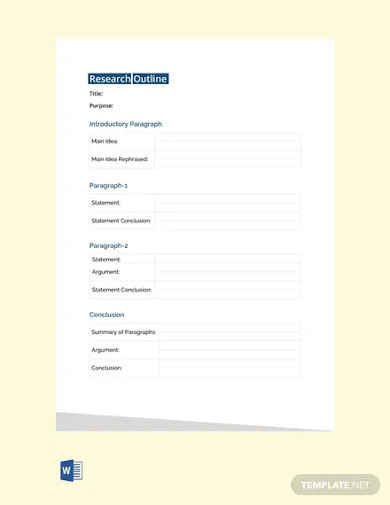
2. Sample Research Paper Outline
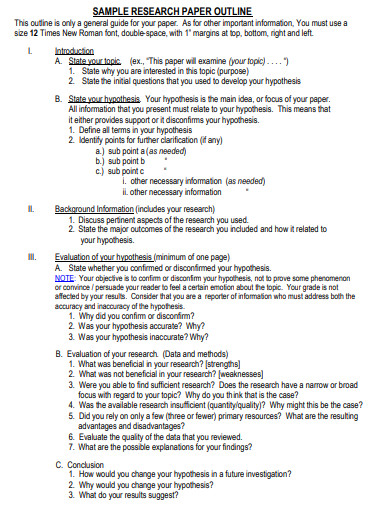
Size: 70 KB
3. Research Essay Outline
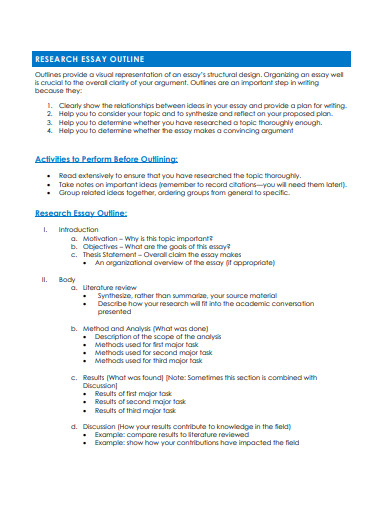
Size: 202 KB
4. Research Project Outline
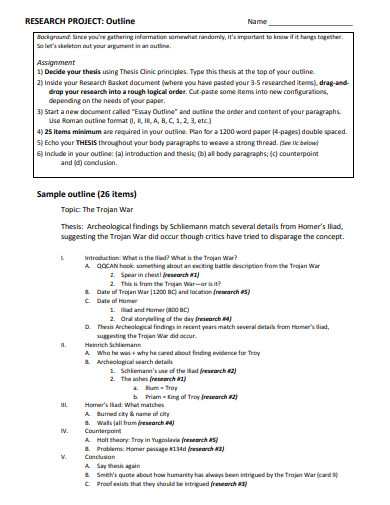
Size: 100 KB
5. Outline of Research Protocol Template

Size: 14 KB
6. Structural Outline of a Research Proposal
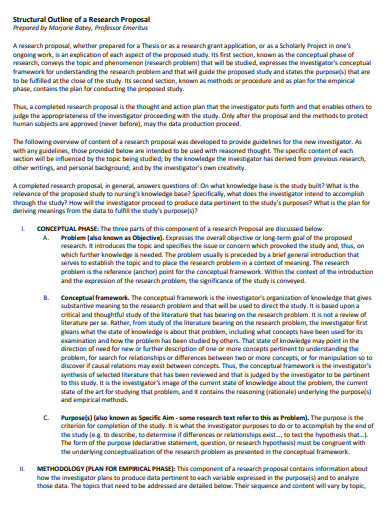
Size: 71 KB
7. Action Research Outline
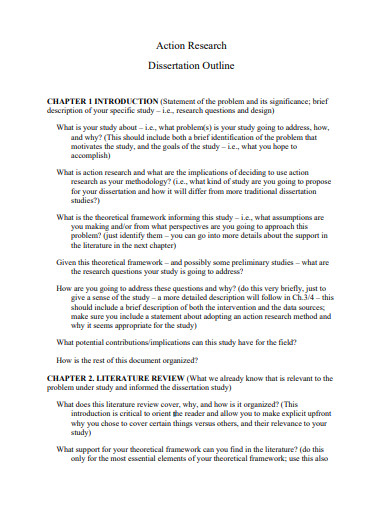
Size: 90 KB
8. Scholars Research Institute Outline
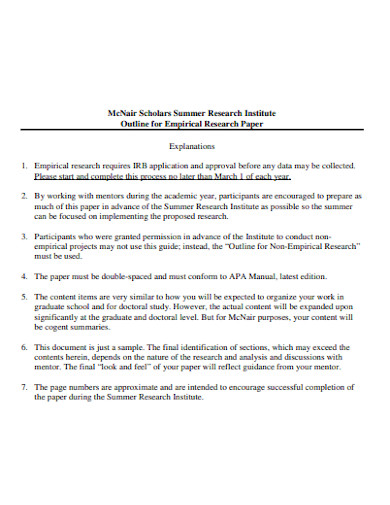
Size: 27 KB
9. Printable Research Outline
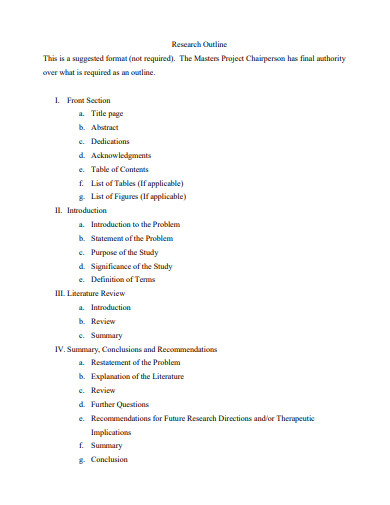
10. Planet Research Project Outline

11. Standard Research Outline Format
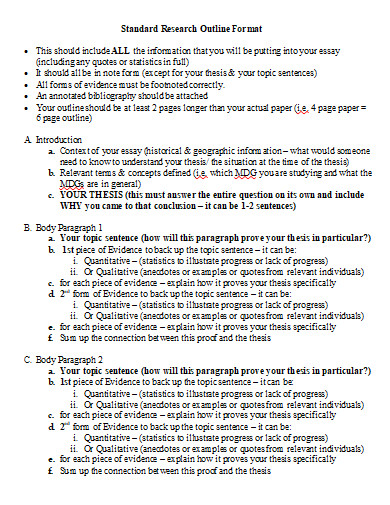
What Is a Research Outline?
To make this research outline definition more simple, imagine a spinal cord or a spinal column in a person’s body. Each piece of spinal column has its own use and has its own purpose to support standing. For a person to be able to stand up in a right way or for them to be able to lean straight. Without this, a person of course has no support for its body. The same goes for a research outline. This is basically what a research outline does. It gives the person support to be able to do their research paper properly . A research outline is a summary of what you plan to write about. It is used as a way to organize your thoughts and ideas for research. The purpose of this research outline is to help your research be able to stand on its own. To be able to help by rearranging and making it less chaotic when you are about to explain it. So when a research outline comes to your mind, think of the use and think of the purpose it has for your research.
How to Write a Research Outline?
Now that we know what a research outline is, and the purpose of a research outline, it is best to know how to write one as well. You mean that there is a way? Yes there is a way to write your very own research outline. Simply by following these simple steps to get there .
1. Place the Title of Your Research
Where do you think the title of your research should be placed? This is often the most asked question when making your research outline. Some outlines would make you write your title in the middle while others would make you write it in the left corner of your document. For a formal kind of research outline, it is always expected that the title of your research be found in the center or in the middle of the paper.
2. Add Your Statement After the Title
The next thing after the title of your research would be the statement. This is found below the title. This is merely a simple one to three sentences maximum. This statement is to explain what your research is simply about. So it does not have to be too long nor too short.
3. Add Numerals for Major Key Points
Rather than just placing the major key points of your research as is, it is always better, cleaner and clearer if you placed Roman Numerals before the major key points. Not only is this the norm, it is also to help you see that the reasons they are placed there is because they are important. If it is a minor key point, you may place them below in letters.
4. Minor Key Points Are Found Below
Just as mentioned above for major key points, when you want to write minor key points, you must place them below each major key point. Avoid writing them in the same place as you would write your major key points. Not only will it be confusing to you, it would also literally turn your outline into a huge chaotic outline. Which is not supposed to be that. Minor key points below the major key points. Minor key points are placed with letters and not numerals. Numerals are mostly used for the major key points.
5. Divide and Subdivide Your Major and Minor Key Points
For how long you plan to write your outline down, everything in the outline must follow the same format. This means that when you divide your major key points, you write them down in the same format as above. If you started with Roman Numerals say I, II, III, continue with it until you are certain that you’re done. The same goes for your minor key points. If your minor key points have their own sub key points or you simply want to add some notes for your sub key points, you may simply put the information below. However this would be alphanumeric before the notes.
What is a research outline?
A research outline is a kind of outline that helps you arrange the ideas you may have into a single and neat file. Research outlines are used to help researchers rearrange their thoughts, ideas and information into something easier to do. Research outlines are the best tools when it comes to summarizing your research for your thesis or for business.
How can a research outline help me?
When doing your research, it is always so taxing and tiring to have to trace or highlight some certain things. An outline helps you by summarizing all the major key details and to include all the minor details. That way, it would be easier for you to just check through the outline, and with that to form your research paper.
Can a research outline be short or long?
A research outline can be as short as only three or four Roman Numerals. It can also be as long as two pages. This is basically up to the person who may be using the outline. But the most common research outline does not have to be a page long.
It goes without saying, when you plan to write a research paper, it could either get very chaotic or very taxing and tiring. The worst case that could happen is when you finally have all your ideas in order but you have nowhere to remember where you found them. This is why a research outline is a useful tool to have. By using this tool, you need not worry about having to highlight back all the information or to summarize things up. You can simply add the major key points in one place and the minor ones in another place.
AI Generator
Text prompt
- Instructive
- Professional
10 Examples of Public speaking
20 Examples of Gas lighting

An official website of the United States government
Here’s how you know
Official websites use .gov A .gov website belongs to an official government organization in the United States.
Secure .gov websites use HTTPS A lock ( Lock A locked padlock ) or https:// means you’ve safely connected to the .gov website. Share sensitive information only on official, secure websites.
JavaScript appears to be disabled on this computer. Please click here to see any active alerts .
Office of Research and Development Strategic Plan

EPA’s Office of Research and Development (ORD) released Strategic Plan guides its mission and ensures that the Agency and our partners have the scientific knowledge, data, and tools needed to protect people and the planet from the most complex and challenging environmental issues of our time.
- ORD Mission
- EPA Foundational Principles
- ORD Principles
- ORD Strategic Goals

ORD Mission
Providing the best available environmental science and technology to inform and support human health and environmental decision making for federal, state, Tribal, local, and community partners, addressing critical environmental challenges and anticipating future needs through leading-edge research.
Leading the world in environmental science, technology, and research, developing breakthrough solutions that enable EPA, federal agencies, states, Tribes, and communities to protect human health and the environment.
EPA Foundational Principles

E PA’s foundational principles form the basis of the Agency’s culture and guide its operations and decision making now and into the future. They are:
- Follow the Science
- Follow the Law
- Be Transparent
- Advance Justice & Equity
ORD Principles
In conducting the critical research that informs and enables the safeguarding of our nation’s health and environment, ORD staff are guided by the following principles:
- We are environmental stewards. I take action to care for and ensure a healthy and thriving environment now and in the future.
- We are an organization of scientific excellence that informs environmental decisions. I diligently use all my talents to contribute significantly to our goals and to fulfilling our mission.
- We actively seek out partnerships that advance the quality, relevance, and impact of ORD’s solutions-driven research. I actively look beyond my own areas of expertise to see how my contributions combine with those of others to fulfill ORD’s mission.
- We exhibit leadership and ownership. I am responsible for developing and exhibiting my leadership.
- We trust each other and are worthy of each other’s trust. I am mindful of others’ trust in me, and I always behave with integrity.
- We communicate honestly, openly, and clearly. I seek the information I need and provide the information that others need in support of a culture of open communication.
- We enable decisions at the most local level possible. I am responsible for actively seeking opportunities to engage others in decision making.
- We value the talents, skills, and experiences of our diverse workforce. I seek to understand, appreciate, and engage others’ unique talents, perspectives, and contributions.
- We are accountable to others for our actions. Forever mindful that our work serves a public trust, I am dedicated to fulfilling our commitments and making the most of our resources.
- We recognize and celebrate our accomplishments. I always recognize and celebrate others for a job well done.
ORD Strategic Goals

ORD has identified four overarching goals to guide its work. The goals are:
- Goal 1: Advance Science and Technology Improve protection of human health and the environment through scientific advancements, innovative research, and technology development using systems-level approaches.
- Goal 2: Support Decision Making Deliver the scientific and technical information our partners need to inform their decisions to protect human health and the environment.
- Goal 3: Build a Healthy Workforce and Organization Strengthen and sustain a workforce and organization that have the skills and expertise necessary to anticipate and respond to current and future challenges to human health and the environment and that value inclusivity.
- Goal 4: Be a Trusted Scientific Source Serve as a trusted source of scientific information for the Agency, the nation, and the world.
Learn More about ORD's Goals and Objectives
ORD has articulated clear and achievable objectives to guide, measure, and meet the four goals outlined above. Learn more about ORD's Goals and Objectives .
- EPA Research Home
- Research Topics
- Publications
- Funding & Career Opportunities
- Stay Connected
- EPA Research Events
- About Our Research
- Science Models and Research Tools (SMaRT) Search
- Strategic Research Action Plans Fiscal Years 2023-2026

Pokémon Go Sustainability Week 2024: all Research Tasks
Check all tasks and rewards Sustainability Week has to offer
- Author: Marco Wutz
Sustainability Week in Pokémon Go runs from April 22 to April 26, 2024, and is a yearly reminder of the threat to our environment – a theme that’s definitely not out of place in a Pokémon game.
Aside from various bonuses , the event has brand-new Field Research Tasks and a couple of Collection Challenges in store to keep players busy. Still, this can’t quite cover up the fact that Sustainability Week has been downgraded in terms of content year after year – a comparison makes it very difficult not to become disappointed.
Be as it may, here are all Pokémon Go Sustainability Week 2024 tasks and rewards .
Pokémon Go Sustainability Week 2024: Field Research Tasks
Field Research Tasks exclusive to Sustainability Week 2024 will be available from spinning the photo discs at PokéStops during the event, which is ending on April 26, 2024, at 8pm local time. Once you’ve got the missions in your inventory, you can complete them whenever you wish.
Here are all Pokémon Go Sustainability Week 2024 Field Research Tasks :
- Catch 5 Pokémon : Binacle
- Catch 10 Pokémon : Foongus
- Explore 1 km : Trubbish
- Explore 2 km : Drilbur
- Hatch an Egg : Combee
Pokémon Go Sustainability Week 2024: Collection Challenges
The Sustainability Week 2024 Collection Challenges need to be completed before the event ends on April 26, 2024, at 8pm local time in order to claim their rewards, so be sure to do so ahead of the deadline.
Here are all Pokémon Go Sustainability Week 2024 Collection Challenges :
Collection Challenge: Drilbur
- Drilbur (Wild, Field Research)
- Excadrill (Evolution)
- Rewards : XP x10,000 and Stardust x5,000
Collection Challenge: Trubbish
- Trubbish (Wild, Field Research)
- Garbodor (Evolution)
As you can see, this event doesn’t have all that much to offer when it comes to missions, so you should be able to complete these tasks with ease and enjoy the small rewards they offer.
Latest Video Game News

Sand Land demo lets you check out the anime RPG early

Valve outlines new Steam Family Sharing plan

The top 10 MLB The Show 24 ratings
UK's Labour Outlines Plan to Renationalise Railways Within 5 Years
UK's Labour Outlines Plan to Renationalise Railways Within 5 Years

A train passes in front of Battersea Power Station as it enters Victoria station in London, Britain, February 10, 2023. REUTERS/Henry Nicholls/File Photo
(This April 24 story has been refiled to say that Arriva is being sold to I Squared, not owned by I Squared, in paragraph 10)
LONDON (Reuters) - Britain's opposition Labour Party said it planned to renationalise the country's rail network within five years without paying compensation to private operators as it set out its plans to fix the troubled railway system.
Britain's train services were privatised in the 1990s but several operators have been renationalised in recent years, some of them losing their franchises after underperforming.
Labour wants to set up a publicly owned Great British Railways which will inherit passenger rail contracts currently held by private firms as they expire, a process it expects to be completed within its first term in office.
The party leads the governing Conservative Party by around 20 percentage points in opinion polls with a national election expected later this year.
"Labour will deliver the biggest overhaul to our railways in a generation," Labour transport policy chief Louise Haigh said ahead of a speech on Thursday setting out the plans.
Photos You Should See - April 2024

Battered by the COVID-19 pandemic and more recently disrupted by industrial unrest, the deteriorating quality of key services has drawn widespread criticism.
Nearly 70% of voters support bringing train operators back into public ownership permanently, a poll conducted this month by polling firm YouGov showed. Fewer than 10% opposed it.
NO SURPRISE
In the 2010s, Britain had several listed transport groups operating rail contracts, but they have either been taken private, such as Go Ahead Group, or exited the sector, such as National Express now Mobico, leaving FirstGroup the only quoted stock.
Shares in FirstGroup, which runs buses and also has contracts for rail services in western England, to Edinburgh from London, and some commuter services in London, fell 2% in early deals. Analysts said FirstGroup's stock does not price in any future rail contracts, hence the small move.
Among the other companies running rail contracts in Britain are Trenitalia which operates the c2c line east of London and Arriva Group, which is being sold to private equity firm I Squared, and they are unlikely to be surprised that their British rail contracts would not be renewed.
"This is not a surprise. Labour have been talking about this for absolutely ages," said Liberum analyst Gerald Khoo. "The only thing that's slightly more tangible is they're much closer to getting into power."
Train operators in Britain will still have a chance to operate some lines as Transport For London outsources some of its connections, such as the Overground which is operated by Arriva.
SUNAK'S PLAN
The current government of Prime Minister Rishi Sunakhas also proposed establishing a new Great British Railways (GBR), company but with a different role.
The government's proposals would group responsibility for rail infrastructure and services under GBR while maintaining a franchise system, giving it the role of contracting out passenger services to private firms.
The government has highlighted the need for private sector involvement to boost efficiency in the network after the coronavirus pandemic reduced commuting by passengers.
Latest statistics show that cancellations in the last three months of 2023 were at their highest level since records began in 2018 although industrial action by staff was a factor behind some of the problems.
Labour said the increases in cancellations and rail fares showed the current system - with four rail operators already managed by the government - had failed.
It said it planned to establish a Passenger Standards Authority to hold GBR accountable for its performance and passengers would be given price guarantees for future fares.
(Reporting by Alistair Smout, additional reporting by Sarah Young; Editing by William Schomberg, Alex Richardson and Daniel Wallis)
Copyright 2024 Thomson Reuters .
Join the Conversation
Tags: United Kingdom , Europe
America 2024

Health News Bulletin
Stay informed on the latest news on health and COVID-19 from the editors at U.S. News & World Report.
Sign in to manage your newsletters »
Sign up to receive the latest updates from U.S News & World Report and our trusted partners and sponsors. By clicking submit, you are agreeing to our Terms and Conditions & Privacy Policy .
You May Also Like
The 10 worst presidents.
U.S. News Staff Feb. 23, 2024

Cartoons on President Donald Trump
Feb. 1, 2017, at 1:24 p.m.

Photos: Obama Behind the Scenes
April 8, 2022

Photos: Who Supports Joe Biden?
March 11, 2020

RFK Jr.: By the Numbers
Laura Mannweiler April 26, 2024

Biden’s Student Loan Chief to Step Down
Lauren Camera April 26, 2024

What to Know: Bird Flu Virus in Milk
Cecelia Smith-Schoenwalder April 26, 2024

Inflation a Stubborn Foe for the Fed
Tim Smart April 26, 2024

The Curse of the Modern Vice President

‘A Rule for the Ages’
Lauren Camera April 25, 2024

Posted by Sponsored Post Posted on 26 April 2024
7 tips how to write a business plan as a college student.

Writing a business plan as a college student can seem daunting, but it’s an excellent way to translate your ideas into a viable business. Whether you’re aiming to start a tech company, a small business, or a social enterprise, a well-crafted business plan is your roadmap to success. Here are seven practical tips to help you create a compelling business plan.
1. Start with a Clear Executive Summary
The executive summary is the hook of your business plan. It should concisely outline your business and why it will be successful. Include key elements like your business name, products or services, and the market needs your business will fulfill.
Key components to include:
- Business idea (what your business does)
- Business goals (what you aim to achieve)
- Target market (who your customers will be)
- Financial summary (the financial outlook of your business)
This summary should highlight your objectives and your plan’s financial goals, enticing readers to delve deeper into your writing. To write a business plan or any other document, you need to be able to capture your audience. If you are struggling with this, you can always order an essay on ukwritings essay service . This site can handle any student request.
2. Conduct Thorough Market Research
Understanding your market is crucial. Dive deep into market research to validate the demand for your product or service. Analyze your competitors, understand your target audience, and identify market trends. This research will solidify your business idea and strengthen your strategies for reaching your market.
Research tips:
- Use online resources and databases
- Conduct surveys and interviews
- Analyze competitor strategies
- Identify industry trends
3. Define Your Business’s Structure
This section should detail your business’s organizational structure, including the roles and responsibilities of your team members. It should also clarify your business’s legal structure (e.g., sole proprietorship, partnership, corporation) and detail the key personnel involved. If it’s just you, explain how you plan to manage all aspects of your business, from sales to accounting.
4. Outline Your Products or Services
What exactly are you selling? Describe your products or services in detail. Explain the benefits they offer and why they are different from or better than what’s already available. Be specific about the features and advantages.
Elements to highlight:
- Unique features of your product/service
- Competitive advantages
- Pricing strategy
- Research and development
5. Develop a Strong Marketing and Sales Strategy
How will you attract and retain customers ? Develop a marketing and sales strategy outlining how to enter the market, attract customers, and achieve your sales goals. Be specific about the channels you will use to reach your audience, such as social media, online marketing, or traditional advertising.
Strategy points to include:
- Marketing channels (online, print, events)
- Sales tactics (discounts, promotions)
- Customer engagement strategies
- Growth tactics for scaling up
6. Create a Detailed Financial Plan
A critical component of your business plan is the financial plan. You must provide detailed financial projections, including startup costs, budget, cash flow, income statements, and balance sheets for the next three to five years. Use realistic assumptions based on your market research to support your projections. If you’re unfamiliar with financial statements, consider using business planning software or consulting an accountant.
Financial documents to prepare:
- Startup costs and capital requirements
- Projected income statement
- Cash flow forecast
- Break-even analysis
7. Review, Refine, and Edit
Your first draft won’t be perfect. Review and refine your business plan thoroughly. Have mentors, advisors, or knowledgeable peers critique your plan. Their feedback can provide invaluable insights that might improve your business’s viability. Finally, proofread your plan for grammatical errors and ensure it’s presented professionally.
Creating a business plan as a college student is an ambitious undertaking, but with these steps, you can craft a plan that not only outlines your business idea but also sets you up for success. Start small, think big, and plan thoroughly to turn your business dreams into reality.
Author: Ryan Mitchell
Ryan Mitchell combines his passion for writing with his experience as a student advisor to offer insightful articles that resonate with readers across educational topics. His expertise helps students navigate academic and personal challenges, enriching his content with practical advice. Dedicated and empathetic, Ryan’s work aims to empower students with knowledge and support.
Share This Article
Latest Articles

Russell ... why do you need a religion to connect ...

The Walk - EP 103 - When does a railway become a c...

Classified With Paul Wallis: The Invasion or Revel...

This is a really great interview with Jason Christ...

John Campbell catches up ... yet AGAIN

Pokemon GO blasted for ERASING women
Popular articles.

How Cognitive Dissonance Gives Religion A Free Pas...

Going deeper in the rabbit hole than ever before.....

The Political Puppets Of The Global Government - D...

Top physicist publishes 'evidence' that we're livi...

Featured News View All

CGI Virology

Elon Musk's Starlink satellites could be eroding E...

Selling Weapons to Murderers in an Upside Down Dem...

Divide and Conquer: The Government’s Propaganda ...

Iran keeper is 'BANNED and fined £3,800' after be...

There’s Nothing “Scientific” About Climate M...

Cult gofer António Guterres calls for UN to have ...

This has been my point since Musk acquired Twitter...

Parliamentary researcher, 29, is charged with spyi...

Headlights, Heart Attacks and Hogwash
Copyright © 2024 David Icke Books Limited. All Rights Reserved.

IMAGES
VIDEO
COMMENTS
Here's an example outline of a research plan you might put together: Project title. Project members involved in the research plan. Purpose of the project (provide a summary of the research plan's intent) Objective 1 (provide a short description for each objective) Objective 2. Objective 3. Proposed timeline
If you want to learn how to write your own plan for your research project, consider the following seven steps: 1. Define the project purpose. The first step to creating a research plan for your project is to define why and what you're researching. Regardless of whether you're working with a team or alone, understanding the project's purpose can ...
A decimal outline is similar in format to the alphanumeric outline, but with a different numbering system: 1, 1.1, 1.2, etc. Text is written as short notes rather than full sentences. Example: 1 Body paragraph one. 1.1 First point. 1.1.1 Sub-point of first point. 1.1.2 Sub-point of first point.
Outline your problem statement ... A research plan helps you, the researcher, organize your thoughts. On the other hand, a dissertation proposal or research proposal aims to convince others (e.g., a supervisor, a funding body, or a dissertation committee) that your research topic is relevant and worthy of being conducted.
Let's delve deeper into the research plan outline process: Step 1: Define the project purpose. Begin by clearly outlining the why and what of your research. Understanding the purpose sets the foundation for your project's goals. Whether you work solo or in a team, a well-defined purpose guides your efforts. For collaborative work, it helps ...
Here is an explanation of each step: 1. Title and Abstract. Choose a concise and descriptive title that reflects the essence of your research. Write an abstract summarizing your research question, objectives, methodology, and expected outcomes. It should provide a brief overview of your proposal. 2.
The outline is the skeleton of your research paper. Simply start by writing down your thesis and the main ideas you wish to present. This will likely change as your research progresses; therefore, do not worry about being too specific in the early stages of writing your outline. Organize your papers in one place. Try Paperpile.
Research Paper Outline. Research paper outline is a plan or a structural framework that organizes the main ideas, arguments, and supporting evidence in a logical sequence. It serves as a blueprint or a roadmap for the writer to follow while drafting the actual research paper. Typically, an outline consists of the following elements:
The proposal outlines the context, relevance, purpose, and plan of your research. As well as outlining the background, problem statement, and research questions, the proposal should also include a literature review that shows how your project will fit into existing work on the topic.
Organize using bold headers or an outline or numbering system—or both—that you use consistently throughout. Start each section with the appropriate header: Significance, Innovation, or Approach. Organize the Approach section around your Specific Aims. Format of Your Research Plan. To write the Research Plan, you don't need the application ...
Research Proposal Format Example. Following is a general outline of the material that should be included in your project proposal. I. Title Page II. Introduction and Literature Review (Chapters 2 and 3) A. Identification of specific problem area (e.g., what is it, why it is important). B. Prevalence, scope of problem.
If your research does not have enough information to support the main idea you are presenting, you should, in general, complete additional research or revise the outline. 4. Organize your outline Consider using one of the following styles: full sentence or alpha-numeric. Alpha-numeric outlines provide less detail than full sentence outlines.
A research plan is a framework that shows how you intend to approach your topic. The plan can take many forms: a written outline, a narrative, a visual/concept map or timeline. It's a document that will change and develop as you conduct your research. Components of a research plan. 1. Research conceptualization - introduces your research question.
Let's look at these steps first, then dive into how to write your outline. 1. Determine your topic. You'll need to establish a topic or the main point you intend to write about. For example, you may want to research and write about whether influencers are the most beneficial way to promote products in your industry.
This will help you align your thoughts. Expand the ideas based on the questions created in the paper outline. After creating a detailed outline, discuss it with your mentors and peers. Get enough feedback and decide on the journal you will submit to. The process of real writing begins.
Creating a plan and outline before starting your research paper can lead to a more successful and satisfying writing process. Contrary to concerns about stifling creativity, planning ahead actually frees your mind from cluttered thoughts and allows for creativity to flourish within the boundaries of your rough plan.
A research plan is a thoughtful, compelling, well-written document that outlines your exciting, unique research ideas that you and your students will pursue over the next half decade or so to advance knowledge in your discipline and earn you grants, papers, speaking invitations, tenure, promotion, and a national reputation.
Writing an outline will also help you focus on the task at hand and avoid unnecessary tangents, logical fallacies, and underdeveloped paragraphs. Identify the research problem. The research problem is the focal point from which the rest of the outline flows. Try to sum up the point of your paper in one sentence or phrase.
Outline for Research Project Proposal. (adapted from Course Materials for Psycholinguistics) When writing, please use section headings to indicate where the information can be found. Subheadings need not be used, though in long sections they may facilitate organization. 1. Introduction Explain the issue you are examining and why it is significant.
A good UX research plan sets out the parameters for your research, and guides how you'll gather insights to inform product development. In this chapter, we share a step-by-step guide to creating a research plan, including templates and tactics for you to try. You'll also find expert tips from Paige Bennett, Senior User Research Manager at ...
A data management plan, outlining how you intend to collect, process, store, document and provide access to your data would be a useful addition to your research proposal. For a prospective funder it would indicate a commitment to good research practice; to your research team it will be a useful practical guide. 8.
Numerals are mostly used for the major key points. 5. Divide and Subdivide Your Major and Minor Key Points. For how long you plan to write your outline down, everything in the outline must follow the same format. This means that when you divide your major key points, you write them down in the same format as above.
Step 4: State your plan or approach; Step 5: Outline your project schedule and budget; Step 6: Tie it all together; Step 7: Edit/proofread your proposal; ... Research past projects, both ...
Webpage outlining ORD's Strategic Plan. ORD Mission Providing the best available environmental science and technology to inform and support human health and environmental decision making for federal, state, Tribal, local, and community partners, addressing critical environmental challenges and anticipating future needs through leading-edge research.
Pokémon Go Sustainability Week 2024: Field Research Tasks. Field Research Tasks exclusive to Sustainability Week 2024 will be available from spinning the photo discs at PokéStops during the event, which is ending on April 26, 2024, at 8pm local time. Once you've got the missions in your inventory, you can complete them whenever you wish.
This Complete Survey Results presentation focuses on how generative AI is helping frequently understaffed cybersecurity teams to analyze and prioritize decisions to mitigate cyber-risk as well as how adept cyber-defenders are at tracking AI-based threats and implementing the right countermeasures.
US News is a recognized leader in college, grad school, hospital, mutual fund, and car rankings. Track elected officials, research health conditions, and find news you can use in politics ...
Writing a business plan as a college student can seem daunting, but it's an excellent way to translate your ideas into a viable business. Whether you're aiming to start a tech company, a small business, or a social enterprise, a well-crafted business plan is your roadmap to success. Here are seven practical tips to help you create a compelling business plan. 1. Start with a Clear Executive ...